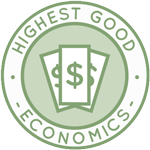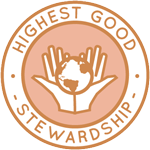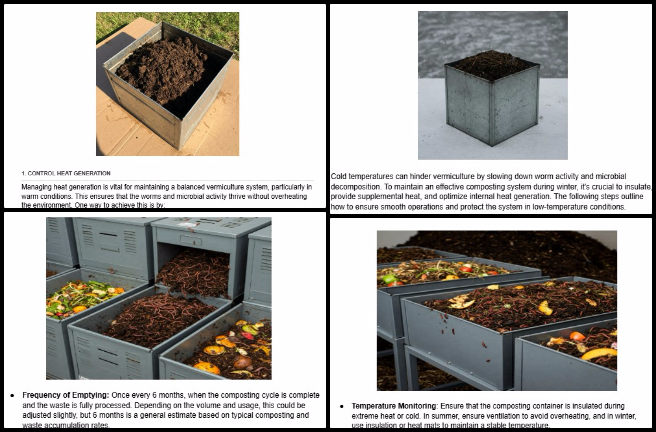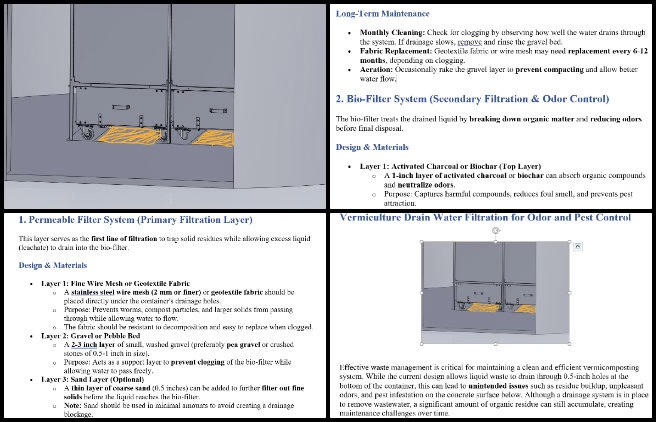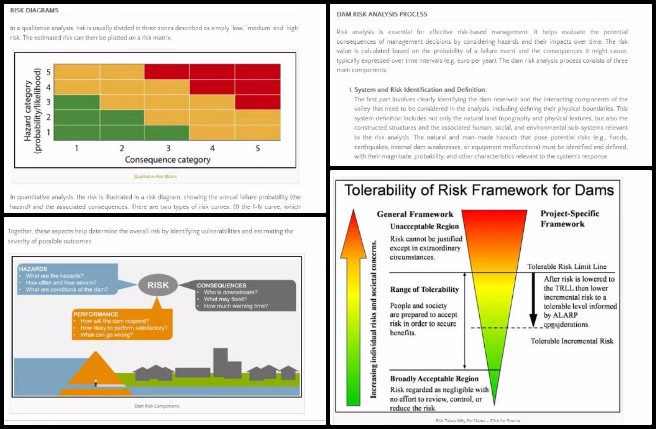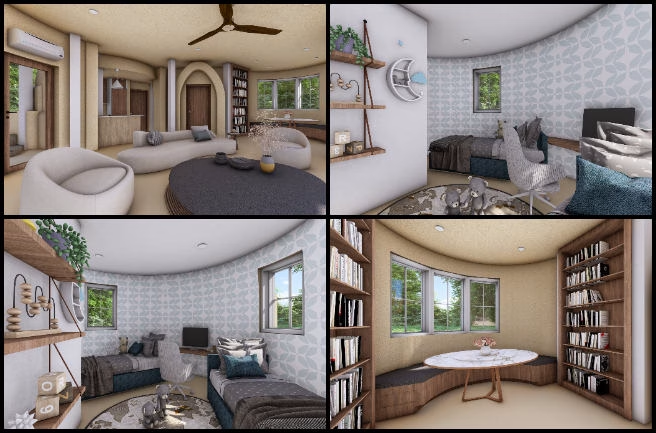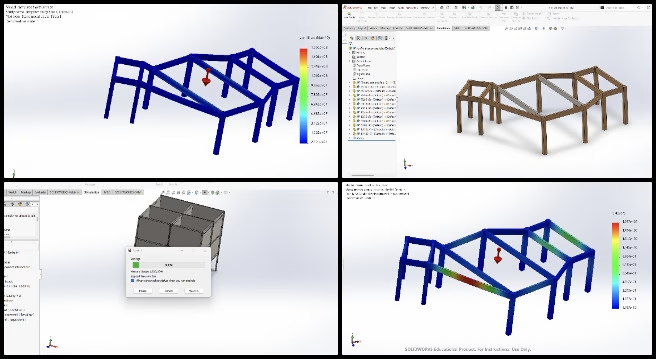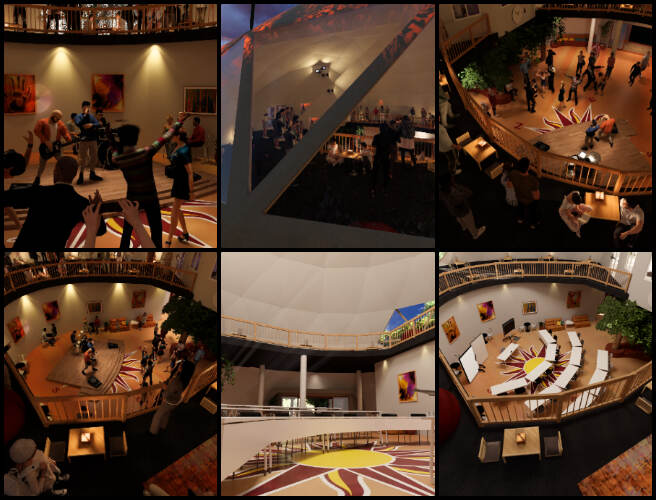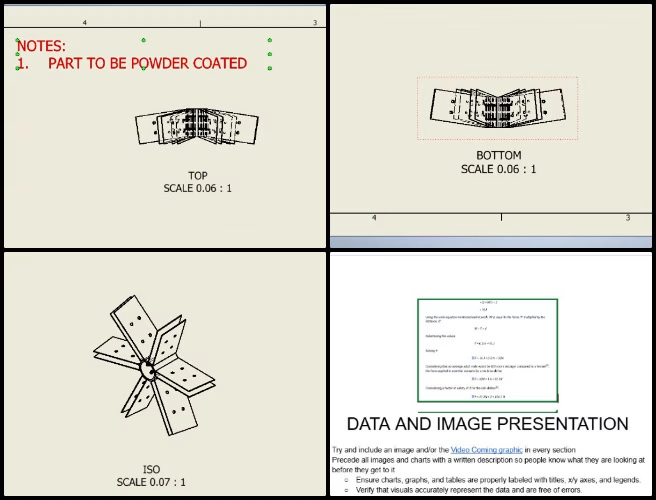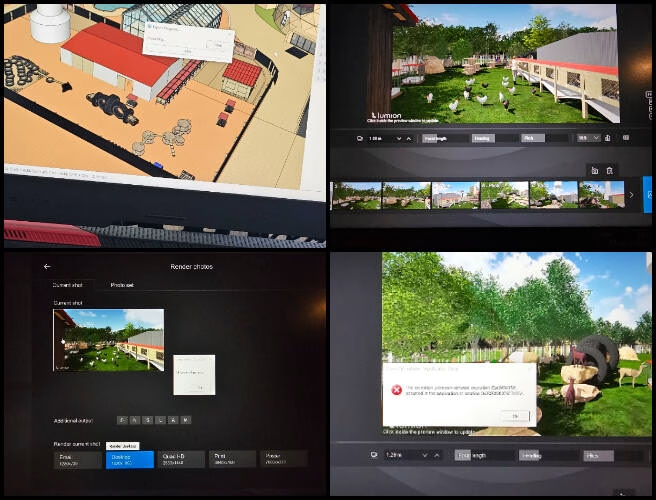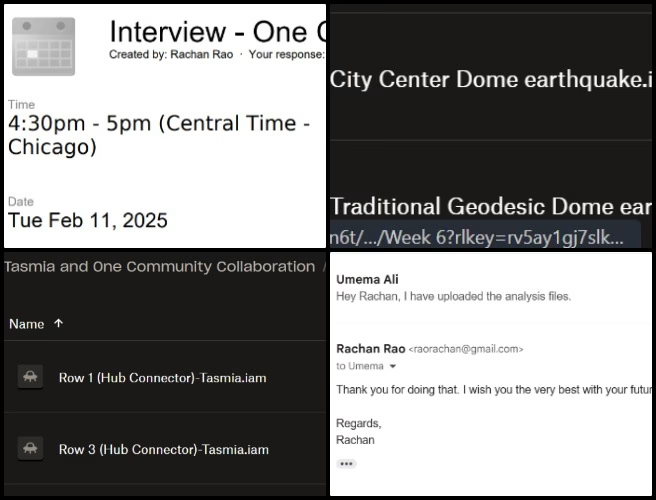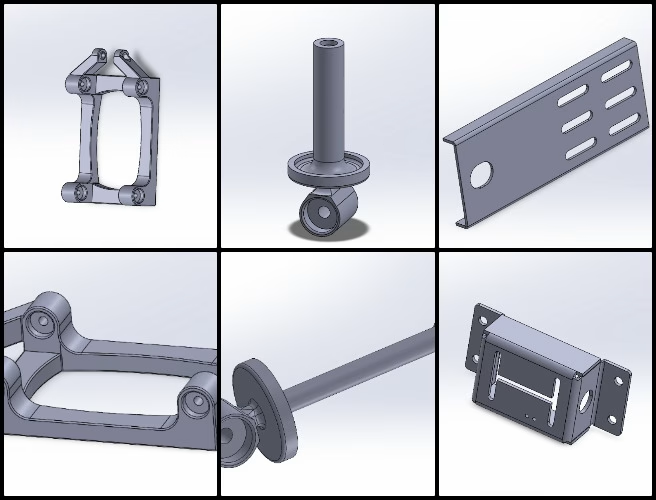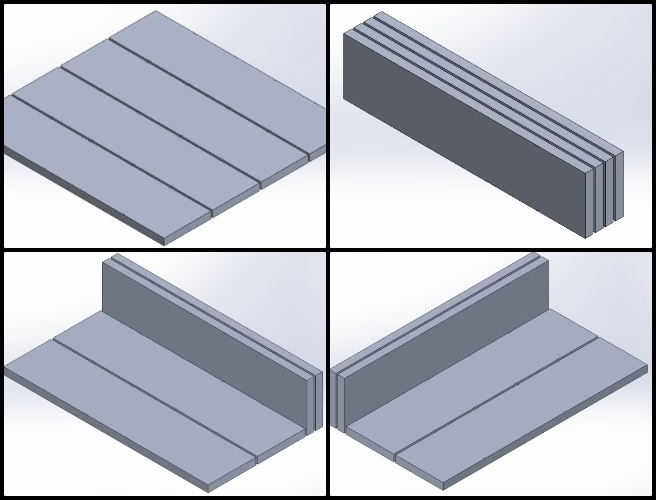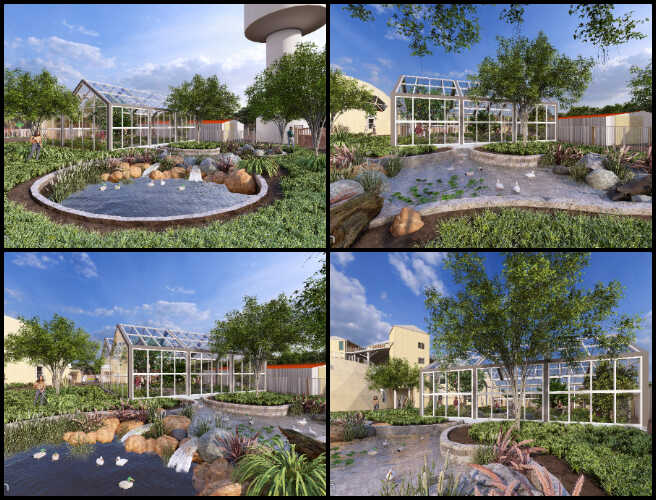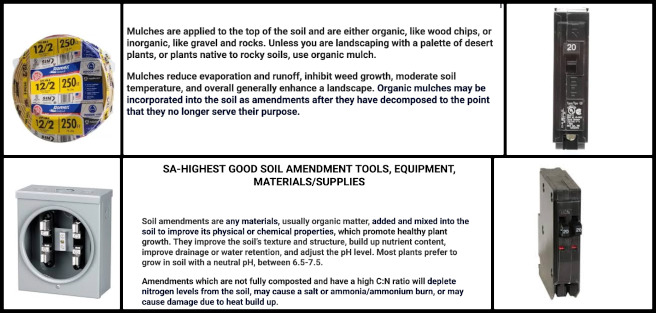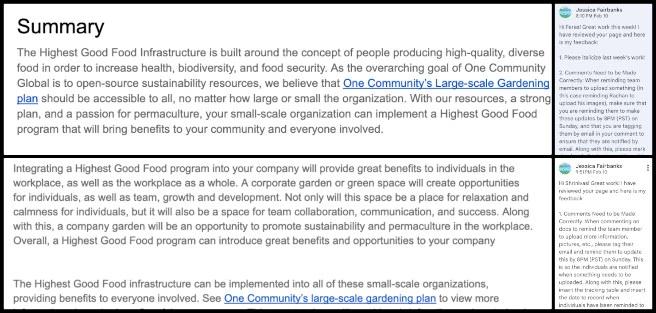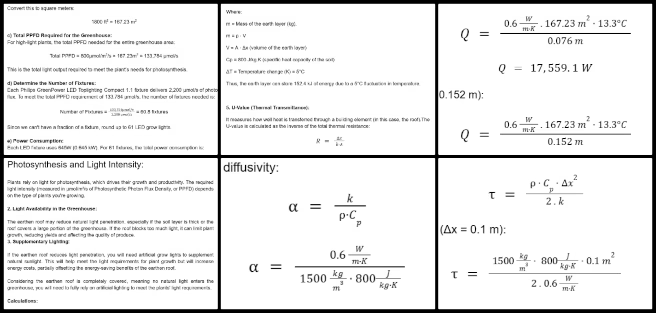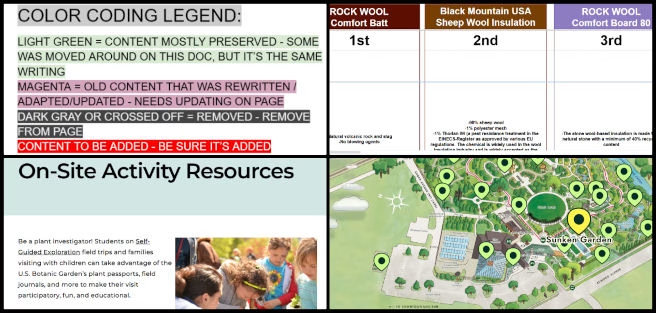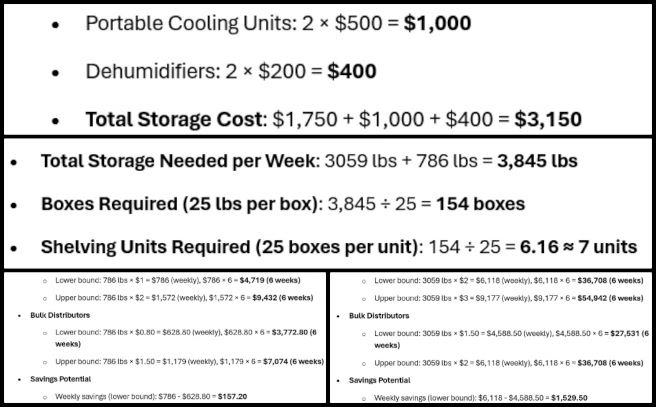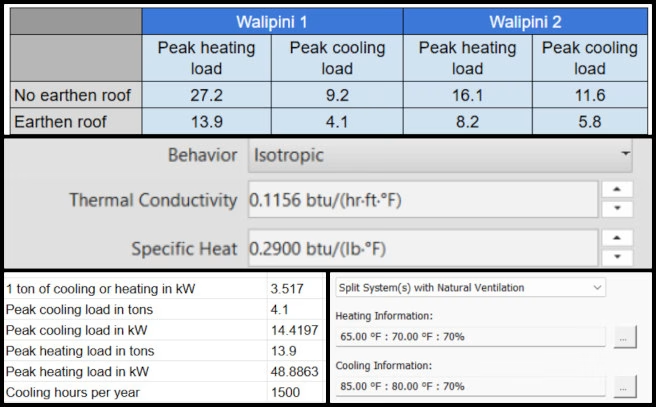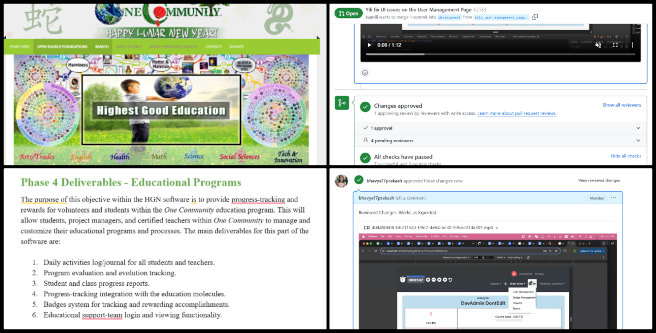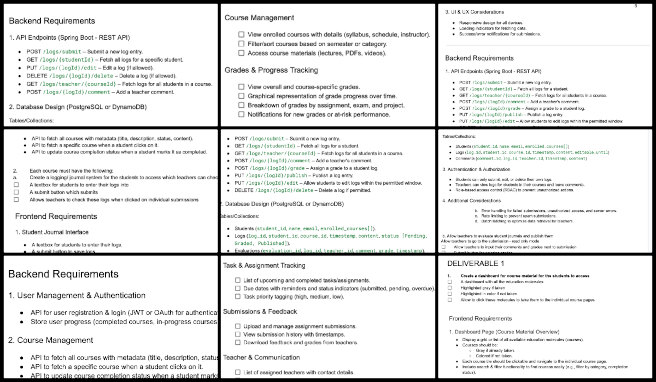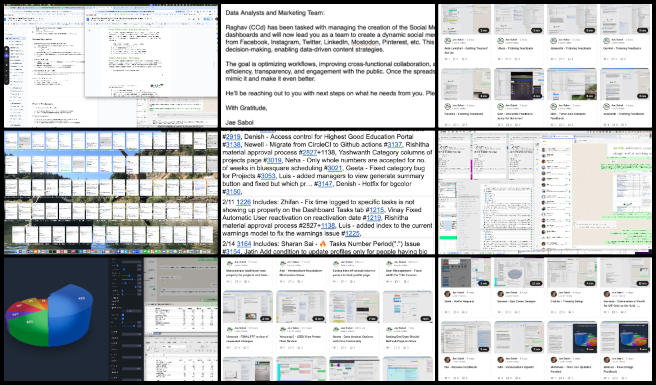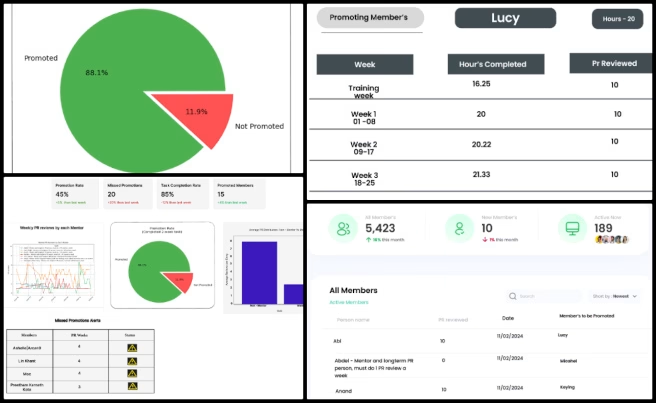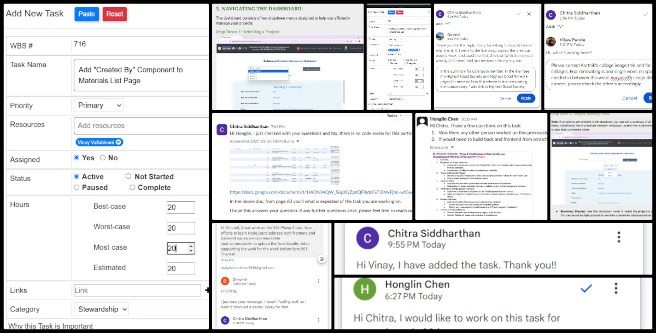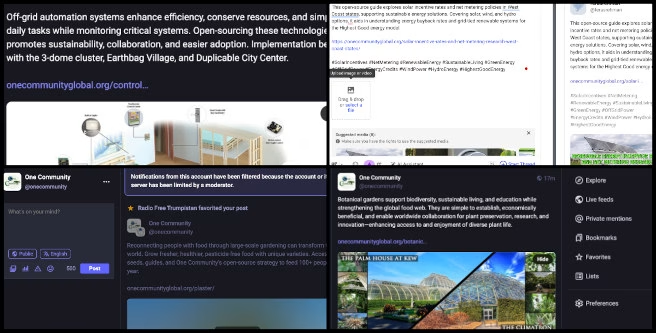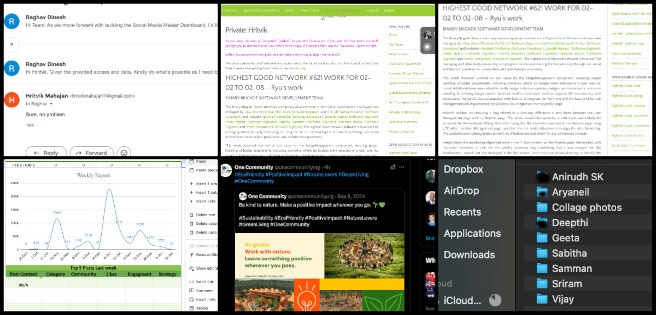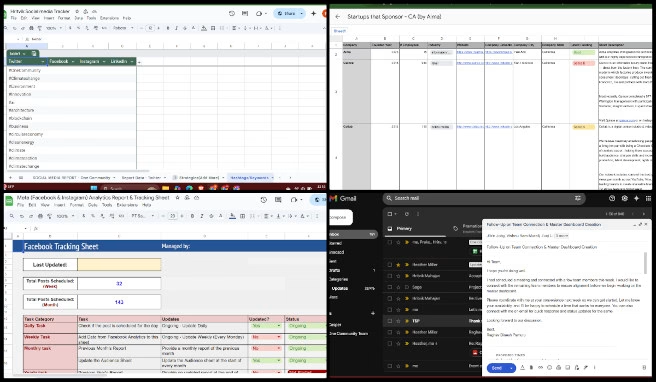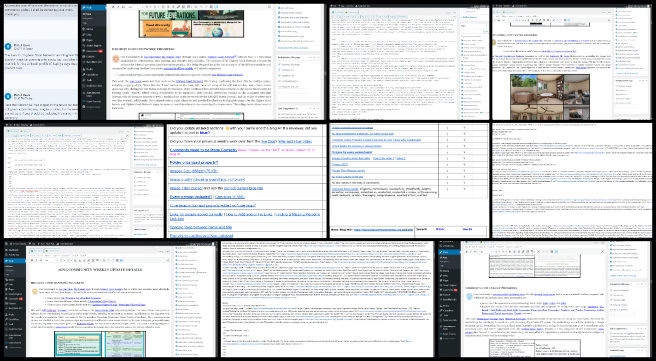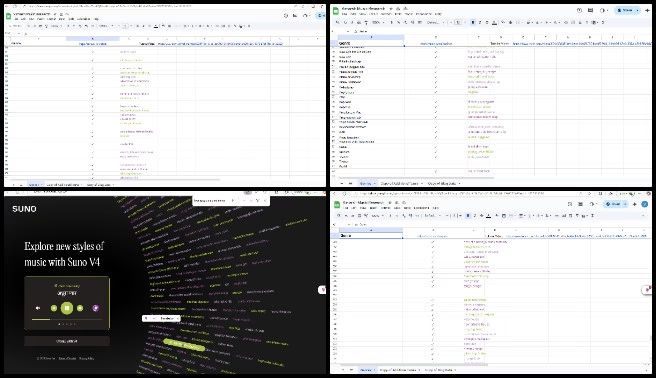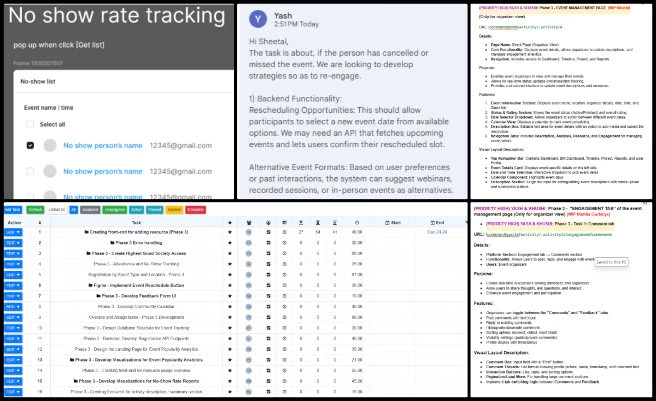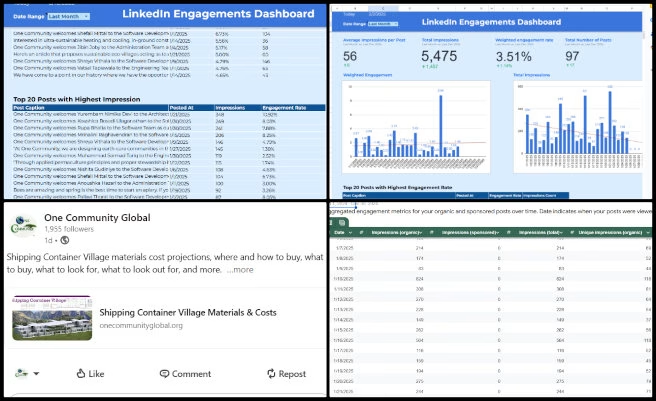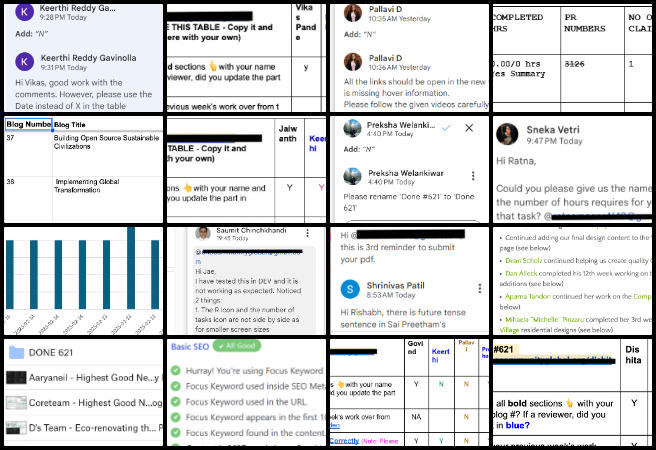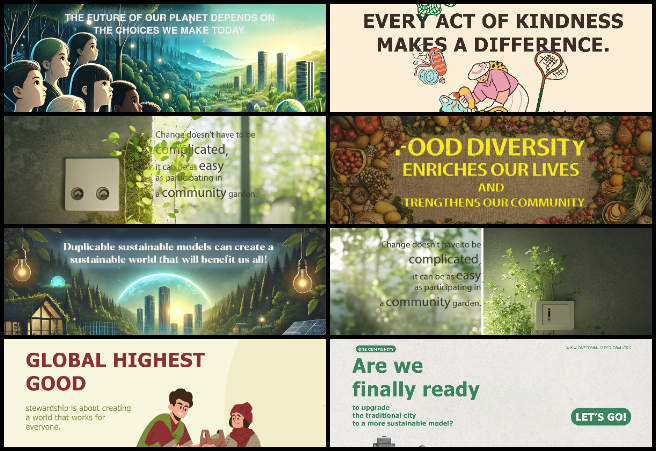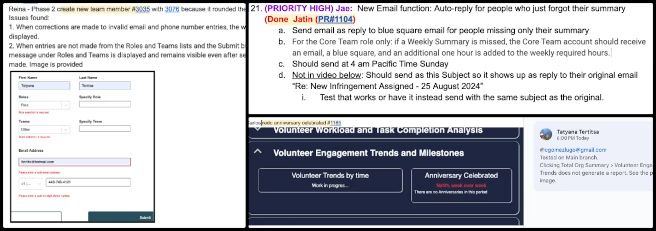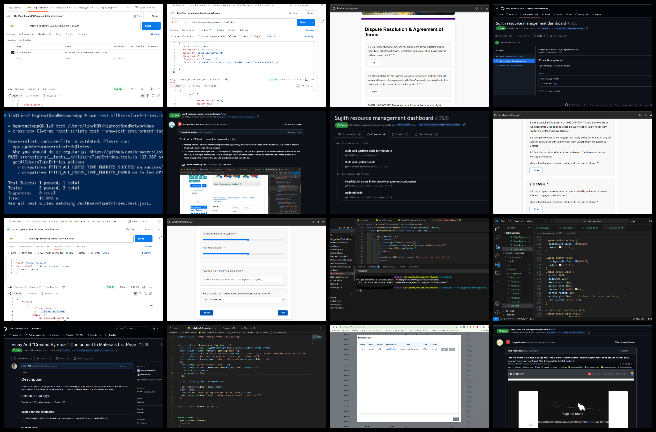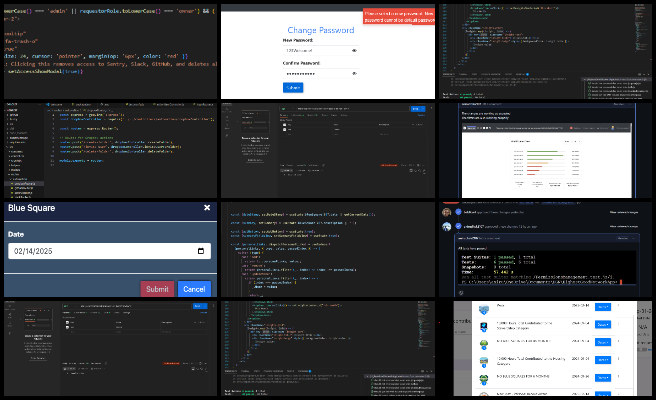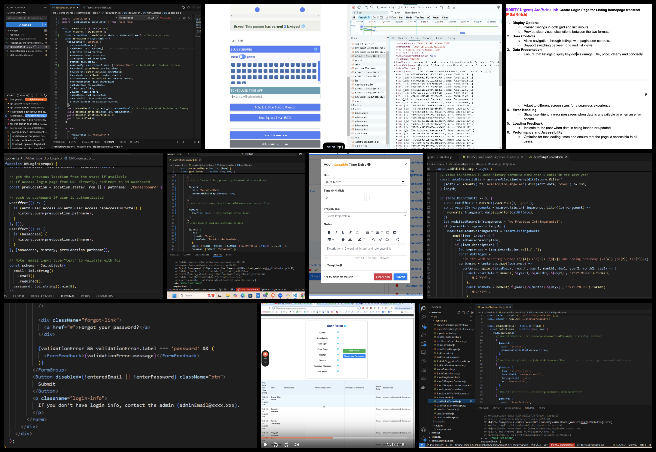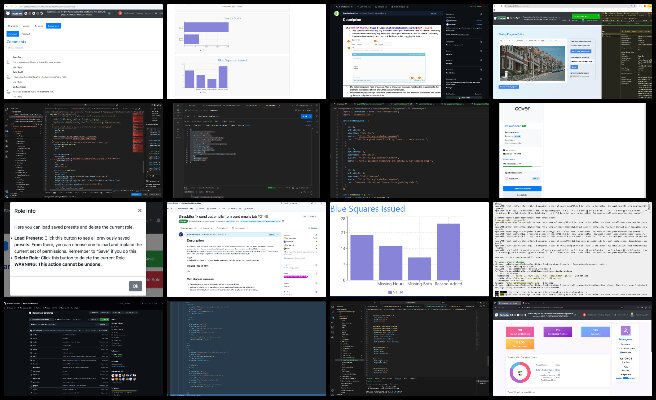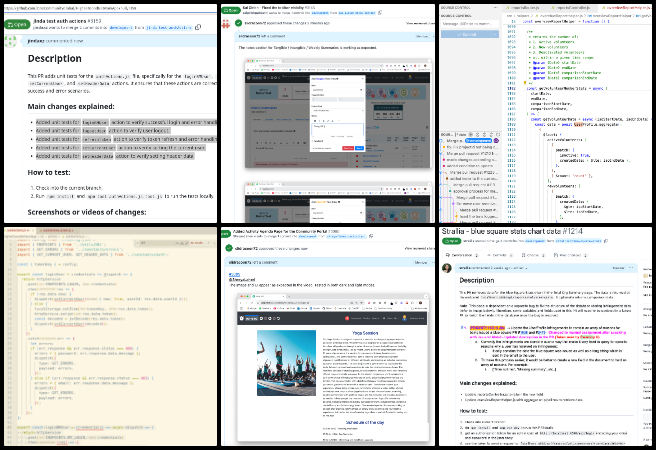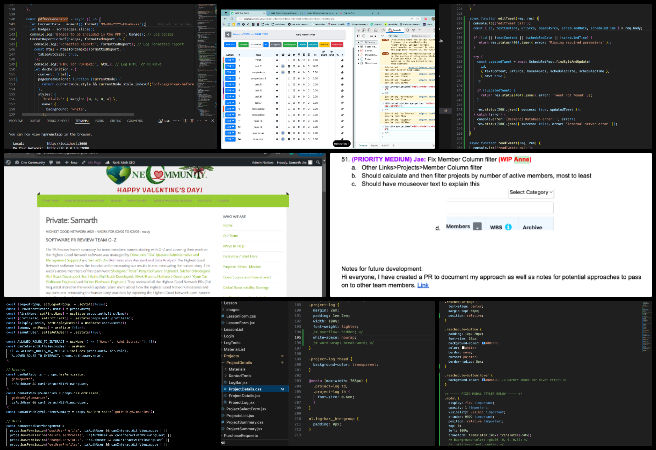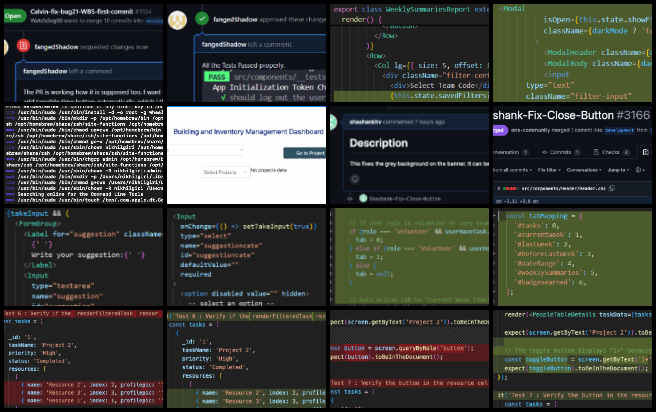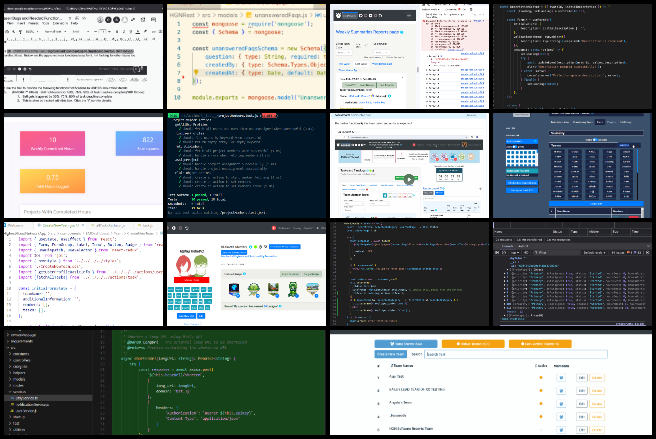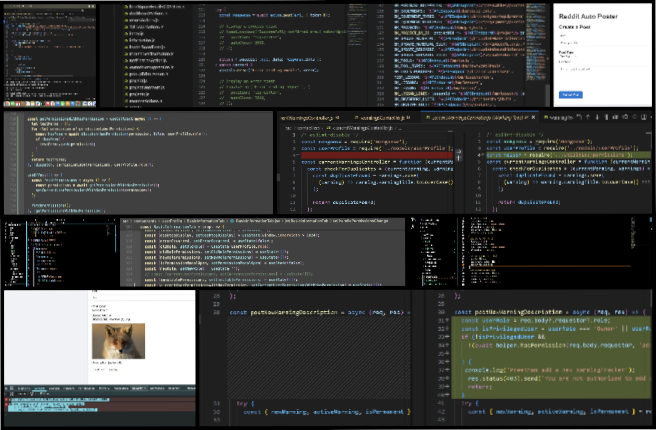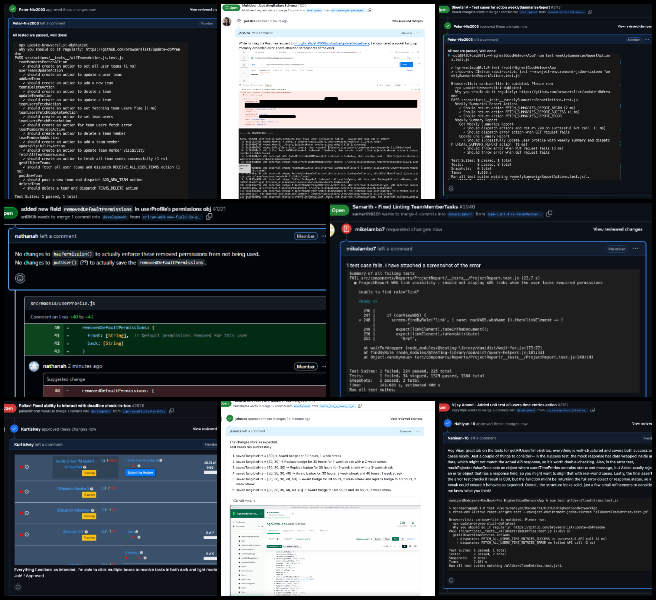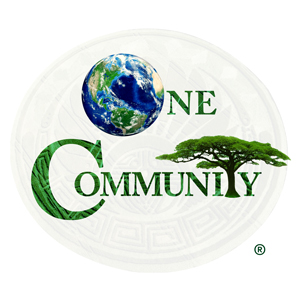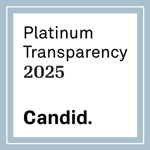Global Game-changing Cooperatives – One Community Weekly Progress Update #622
At One Community, we are designing global game-changing cooperatives by developing sustainable approaches to food, energy, housing, education, economics, and social architecture, Our all-volunteer team is dedicated to creating a self-replicating model of fulfilled living and global stewardship practices, designed for “The Highest Good of All.” By open sourcing and free sharing the complete process, we aim to establish a global collaboration of teacher/demonstration hubs that evolve sustainability, regenerate our planet, and create a world that works for everyone. Join us in building a future where innovative solutions are accessible to all, fostering a legacy of collective progress and shared responsibility.
- Here’s our project overview
- Here’s our world-change methodology
- Here’s how this becomes self-replicating
- Here’s how we are open source and free-sharing all the do-it-yourself designs
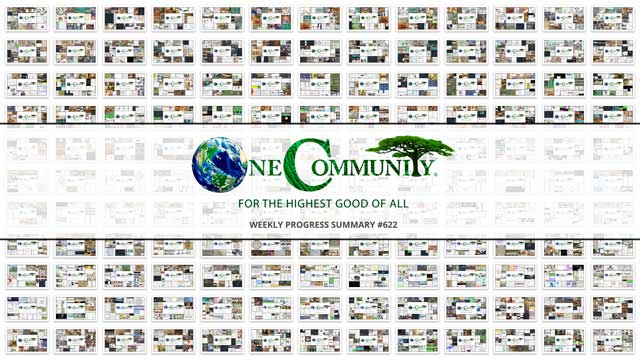
OUR MAIN OPEN SOURCE HUBS
Click on each icon to be taken to the corresponding Highest Good hub page.
One Community’s physical location will forward this movement as the first of many self-replicating teacher/demonstration communities, villages, and cities to be built around the world. This is the February 17th, 2025 edition (#622) of our weekly progress update detailing our team’s development and accomplishments:
Global Game-changing Cooperatives
One Community Progress Update #622
DONATE | COLLABORATE | HELP WITH LARGE-SCALE FUNDING
CLICK HERE IF YOU’D LIKE TO RECEIVE AN EMAIL EACH WEEK WHEN WE RELEASE A NEW UPDATE
YOU CAN ALSO JOIN US THROUGH SOCIAL MEDIA
ONE COMMUNITY WEEKLY UPDATE DETAILS
HIGHEST GOOD HOUSING PROGRESS
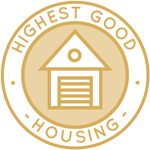 One Community is designing global game-changing cooperatives through Highest Good housing that is artistic and beautiful, more affordable, more space efficient, lasts longer, DIY buildable, and constructed with healthy and sustainable materials:
One Community is designing global game-changing cooperatives through Highest Good housing that is artistic and beautiful, more affordable, more space efficient, lasts longer, DIY buildable, and constructed with healthy and sustainable materials:
- Learn about: Our Upcoming Crowdfunding Campaign
- Learn about the different village models: 7 Sustainable Village Models
- Visit the open source portals for the first two: Earthbag Village OS Hub | Straw Bale Village OS Hub
This week, Adil Zulfiquar (Engineer) continued working on the Vermiculture Toilet engineering designs. The vermiculture report content was updated for website publication, including a review of the existing document, removal of previous designs, and addition of the latest information. The vermiculture operating conditions report was modified with new pictures for visual representation and formatting adjustments. The Earthbag Village, the first of seven planned villages, serves as the initial housing component within One Community’s open source model for global game-changing cooperatives. See below for some of the pictures related to this work.
Anil Karathra (Mechanical Engineer) continued advancing the engineering and design of the Vermiculture Toilet for the Earthbag Village project. The knockdown mechanism was revised based on feedback from Jae, and related CAD models were created. Participation in the weekly team meeting included reviewing and assigning tasks to teammates. Research focused on wastewater drainage methods for the vermiculture chamber, as well as odor and pest control using a natural filtration system. Findings on drain water filtration were documented and formatted, and corresponding CAD models were developed. Screenshots of the work completed during the week were uploaded to Dropbox. This commitment to global game-changing cooperatives drives the development of innovative, eco-friendly solutions that balance environmental responsibility with high standards of functionality. See below for pictures related to this work.
Charles Gooley (Web Designer) continued working on the Open Source DIY Dam Design for Water Retention, Pond and Lake Creation, etc. page. The updates included rewording, clarifications, and additions to the tables of contents. New content was added to the Dam Risk Analysis and Management section, covering dam risk analysis, assessment, risk tolerability for dams, risk diagrams, and dam risk management. Dam Design is important for the Earthbag Village, a foundational part of One Community’s open-source model for global game-changing cooperatives. Take a look at some of the work in the images below.
Faeq Abu Alia (Architectural Engineer) continued his work on the Earthbag Village 4-dome home renders. Faeq refined the interior layout and finishes for the first room, second bedroom, and living room. The work focused on improving functionality, aesthetics, and coherence, with attention to material selection and visual composition. Feedback was incorporated to enhance space utilization and maintain design consistency. Adjustments included evaluating layout configurations, selecting finishes, and ensuring a cohesive visual flow throughout the spaces. The Earthbag Village is the first of 7 to be built as the housing component of One Community’s open source model for global game-changing cooperatives. View examples of this work in the pictures provided below.
Karthik Pillai (Mechanical Engineer) continued helping finish the Vermiculture Toilet engineering and helping with the Earthbag Village 4-dome home roof plan. Karthik worked on the four-dome cluster roof design, integrating an updated roof joist layout into the structural model. Columns and joists were designed based on the provided blueprint to align with revised specifications. Simpson brackets were added to improve the accuracy of the finite element analysis (FEA), and the updated analysis results were uploaded to Dropbox. Work also continued on the vermiculture toilet design, focusing on research related to worm decomposition to better understand the biological processes involved. Additionally, FEA was performed on the Unistrut structure to assess its structural integrity, and relevant screenshots documenting the analysis were uploaded to Dropbox. The Earthbag Village is the first of 7 to be built as the housing component of One Community’s open source model for global game-changing cooperatives. See the work in the collage below.
Michaela Silva (Architect) continued working on the interior details for the Earthbag Village 4-dome home design. Michaela worked on integrating the electrical design into the Revit model. She located and sized the breaker box for the panel and marked up electrical drawings for updates. She also reviewed the structural roof design and explored adding extra columns to support the deflection of the main living space beams. As the first of seven villages in One Community’s open source plan for global game-changing cooperatives, the Earthbag Village represents the housing element. See her work in the collage below.
Yi-Ju Lien (Environmental Engineer) continued her work on the Earthbag Village LEED points related to stormwater retention. Yi-Ju continued integrating the current design to ensure consistency across all systems. She gathered historical rainfall data from the Kanah, UT station and re-evaluated the rainwater harvesting system, calculating the water supply capacity based on updated rainfall and catchment data. Additionally, she reorganized the structure of the webpage content, focusing on the stormwater management section, highlighting the importance of maintaining collaboration and unity in global game-changing cooperatives. See some of the work done in the collage below.
DUPLICABLE CITY CENTER PROGRESS
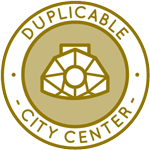 One Community is designing global game-changing cooperatives through a Duplicable and Sustainable City Center that is LEED Platinum certified/Sustainable, can feed 200 people at a time, provide laundry for over 300 people, is beautiful, spacious, and saves resources, money, and space:
One Community is designing global game-changing cooperatives through a Duplicable and Sustainable City Center that is LEED Platinum certified/Sustainable, can feed 200 people at a time, provide laundry for over 300 people, is beautiful, spacious, and saves resources, money, and space:
- Learn about this building and it’s function: Duplicable City Center Open Source Hub
Jason Bao (Architectural Designer) continued working on producing renders for the Duplicable City Center library. He provided feedback, and team members shared files for further modifications. Updates to the concert scene were made based on Jae’s requests, including adding more people, removing a window, and incorporating a dancing group. A new batch of renders was produced and uploaded. The final rendering for the concert scene was completed and uploaded as well. The class scene has been set up with furnishing models completed and added to the Lumion file. Cameras, rendering settings, and lighting were set up for a daytime class test shot, which was rendered and uploaded to Dropbox while awaiting Jae’s feedback. The Duplicable City Center is a foundational part of One Community’s open-source model, which excels in designing global game-changing cooperatives. This approach is integral to their mission of global game-changing cooperatives through innovative and scalable solutions. See some of this work in the pictures below.
Manjiri Patil (Mechanical Design Engineer) redesigned the connector to simplify the creation of 2D drawings. She also finalized and optimized an Excel-based checklist to enhance the documentation process. Additionally, she incorporated images into the original document as a visual reference. After receiving feedback from Jae, Manjiri is now implementing the suggested changes to further improve the document’s clarity and accuracy. The Duplicable City Center is a key component of One Community’s open-source framework for designing global game-changing cooperatives. The images below showcase some of this work.
Nimika Devi (Architect) continued her contributions to the landscape design and development of the Duplicable City Center‘s outdoor areas. The work focused on the previous model, but technical issues prevented progress. Attempts to render the model were unsuccessful as the software repeatedly crashed and failed to generate renders. Additionally, there were difficulties in saving the file, further complicating the workflow. One Community’s open-source framework promotes global game-changing cooperatives, with the Duplicable City Center as a core element. The images below showcase some of this work.
Rachan Rao (Project Manager) continued working on the cost analysis for Off-Grid energy implementation in the HGE project. He organized and conducted interviews with potential candidates for the Duplicable City Center design and analysis team. He also worked with former employees to finalize their tasks on Dropbox. Additionally, Rachan provided updates and communicated with the team regarding their progress on tasks and developments related to the DCC U-hub connector design and drawing. In designing global game-changing cooperatives, One Community leverages its open-source framework, featuring the Duplicable City Center as a central tool. The images below showcase some of this work.
Rudrani “Sravya” Mukkamala (Mechanical Engineer) continued researching the structural components of a hydraulic elevator, focusing on the framework, guide rails, and load-bearing elements. She designed several parts for the hoistway, including attachment components, smaller elements, and additional parts intended to fit around the larger components. These parts were designed to secure and fix other elements within the hoistway. Considerations were also made for the integration of these parts with other elements of the system. A list was created detailing the parts that still need to be designed, ensuring all necessary components are accounted for in the overall assembly. Global game-changing cooperatives are supported by One Community’s open-source framework, and the Duplicable City Center is essential to this design. The images below showcase some of this work.
Sanket Basannavar (Mechanical Engineer) continued working on the Duplicable City Center spa cover as part of the City Center Natural Pool and Eco-spa Designs. A new spa cover design was developed for a 10′ x 10′ square pool. The design allows for partial or full access to the spa, utilizing four panels measuring 28″ x 120″ each, attached along their thickness. When partial access is needed, the cover opens in a configuration shown in the second and third reference images, while full access follows the configuration in the fourth image. Initial considerations for integrating an electric motor for automated opening and closing were also explored. In designing global game-changing cooperatives, One Community leverages its open-source framework, featuring the Duplicable City Center as a central tool. The images below showcase some of this work.
Yan “Jenni” Zu (Architectural Designer) continued her work on the greenhouse area of the Duplicable City Center. She completed the final adjustments for the greenhouse renderings, ensuring all design elements were accurate and visually consistent. She focused on refining lighting, textures, and materials to enhance the overall quality. Additionally, Jenni rendered multiple views from various angles to provide a more comprehensive understanding of the greenhouse design. These renderings capture the different perspectives of the interior and exterior spaces, highlighting key features such as plant arrangements, pathways, and structural details. Within One Community’s open-source framework, the Duplicable City Center plays a central role in designing global game-changing cooperatives. The images below showcase some of this work.
HIGHEST GOOD FOOD PROGRESS
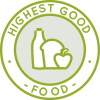 One Community is designing global game-changing cooperatives through Highest Good food that is more diverse, more nutritious, locally grown and sustainable, and part of our open source botanical garden model to support and share bio-diversity:
One Community is designing global game-changing cooperatives through Highest Good food that is more diverse, more nutritious, locally grown and sustainable, and part of our open source botanical garden model to support and share bio-diversity:
- Learn about the structures: Hoop House Hub | Aquapini & Walipini Open Source Hub
- See what we’ll be growing: Gardens & Hoop Houses | Large-scale Structures | Food Forest | TA
This week, the core team finalized the Tool and Equipment needs for the Goat, Chicken, and Rabbit documentation. Then they performed an in-depth review of the initial 100 pages of the Master Tools, Equipment, and Materials/Supplies document. This review specifically focused on identifying and addressing instances of duplicate entries and providing necessary revisions that had accumulated during the document’s extended compilation period. Recommendations were made to remove these duplicate entries from the associated website. The Highest Good Food initiative is a key component of One Community’s open source plans, focused on global game-changing cooperatives, and exemplifies the organization’s commitment through innovative design and implementation. Below are some of the images showcasing this work.
Jay Nair (BIM Designer) continued working on Aquapini and Walipini Planting and Harvesting lighting and HVAC design. He added a paragraph explaining the justification for additional energy use in greenhouse cultivation, detailing factors contributing to increased energy demands. Some introductions were included to provide context and structure to the document. Formatting changes were made to specific sections to improve readability, ensure consistency, and align the content with project standards. One Community’s open source plans for global game-changing cooperatives feature the Highest Good Food initiative as a key component, exemplifying the organization’s commitment through innovative design and implementation. Below are some of the images showcasing this work.
Jessica Fairbanks (Administrative Assistant) completed her edits to the project on the integration of Highest Good Food into small-scale organizations in preparation for a final review. She also reviewed the work of fellow administrators, providing detailed feedback. In addition, Jessica completed her weekly administrative tasks and scheduled an interview with a potential new volunteer. Exemplifying the organization’s commitment through innovative design and implementation, the Highest Good Food initiative represents a key component of One Community’s open source plans for global game-changing cooperatives. Her contributions are highlighted in the collage below.
Junyi Shi (Landscape Architect) continued working on finalizing the render details for Walipini #2 as a part of Aquapini and Walipini Planting and Harvesting project. She reviewed and organized project files, ensuring that all elements were properly documented. The final version of the animation was adjusted and rendered, incorporating necessary refinements to improve accuracy and presentation. Throughout the process, previous design iterations were analyzed to ensure consistency and alignment with the overall project vision. In addition to finalizing the animation, a new descriptive report was written to provide a detailed overview of the design. This report integrates insights from earlier design summaries, outlining key aspects such as spatial planning, structural elements, and thematic considerations. With its innovative design and implementation, the Highest Good Food initiative is a key component of One Community’s open source plans for global game-changing cooperatives, exemplifying the organization’s commitment. Her contributions are highlighted in the collage below.
Kishorre Annanth Vijayan (Mechanical Engineer) continued working on Aquapini and Walipini designs. He focused on performing heat transfer, lighting, and ventilation calculations for a greenhouse with and without an earthen roof. For the earthen roof, calculations included heat transfer through the earth layer using Fourier’s law, thermal diffusivity, temperature distribution, and optimizing the thickness of the earth layer to improve temperature regulation and energy savings. Additionally, the thermal resistance of the earth layer, the heat flow through a composite wall, U-value, building energy demand, and time lag for temperature fluctuations were evaluated. The effect of air gaps on heat transfer and long-term performance analysis for seasonal heat storage were also considered. The potential of global game-changing cooperatives to revolutionize sustainable agriculture and community development informed his approach.
Lighting calculations were made for both summer and winter, where summer conditions required no artificial lighting, and winter required 46 LED grow lights to meet the necessary light levels for plant growth. Ventilation calculations determined a required airflow of 27,538.5 m³/h, with six fans needed to meet this requirement. A comparison was made for the scenario without an earthen roof, showing that heat transfer efficiency was reduced, energy demand was higher, and thermal mass was absent, leading to more reliance on artificial heating and cooling systems. The effects of air gaps, thermal insulation properties, and the overall efficiency of the greenhouse were also assessed. The Highest Good Food initiative is a key component of One Community’s open source plans, focused on global game-changing cooperatives, and exemplifies the organization’s commitment through innovative design and implementation. Below are some of the images showcasing this work.
Mary Nelson (Landscape Planner) organized the information she had gathered and integrated it into the existing One Community Botanical Garden tutorial. She completed the graph and log templates, designing them to align with One Community’s themed graphs and charts. She also reviewed the tutorial again and identified sections that needed to be removed due to redundancy or lack of clarity. The Highest Good Food initiative, a key component of One Community’s open source plans for global game-changing cooperatives, showcases the organization’s commitment through its innovative design and implementation. Her contributions are highlighted in the collage below.
Tanmay Koparde (Industrial Engineer And Team Administrator) calculated Food Procurement storage requirements to optimize space utilization, focusing on sourcing from local suppliers and large-scale distributors while implementing optimized storage practices to maintain freshness and minimize waste. He also reviewed the training of Dishita, Vikas, Jaiwanth, Govind, and Prasannadevi, suggesting improvements for their training blogs. In its open source plans for global game-changing cooperatives, One Community features the Highest Good Food initiative as a key component, exemplifying the organization’s commitment through innovative design and implementation. See his work in the collage below.
Vatsal Tapiawala (Mechanical Engineer) completed his report on the earthen roof by incorporating the feedback he received and finalized the structural analysis of Walipini 1. He detailed considerations for different internal and external environments, analyzing their impact on thermal loads. He also collaborated with his teammate to calculate the total cost, ensuring that all factors affecting energy consumption and expenses were accounted for. Focused on global game-changing cooperatives, One Community’s open source plans include the Highest Good Food initiative as a key component, exemplifying the organization’s commitment through innovative design and implementation. See his work in the collage below.
HIGHEST GOOD ENERGY PROGRESS
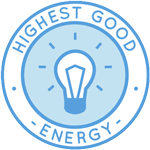 One Community is designing global game-changing cooperatives through Highest Good energy that is more sustainable, resilient, supports self-sufficiency and includes solar, wind, hydro and more:
One Community is designing global game-changing cooperatives through Highest Good energy that is more sustainable, resilient, supports self-sufficiency and includes solar, wind, hydro and more:
- Learn about the open source sustainable-energy foundations: Solar, Hydro, and Wind
- Explore our research into the most sustainable products and companies for saving water and energy: Insulation, Eco-laundry, Lightbulbs and Light Bulb Companies, Doors and Door Companies, Windows and Window Companies, Toilets, Faucets and Faucet Accessories, Urinals, and more.
This week, Muhammad Sarmad Tariq (Electrical Engineer) submitted the methodology for calculating the profit of a grid-tie vs off-grid solar PV system to Jae. This methodology, which involves calculating the savings obtained for each system, the energy cost for deficient units, investment costs, and battery replacement costs, is written in the Google doc and is being refined for entry into the Excel sheet. The Highest Good Energy initiative is a key component of One Community’s open-source plans, focused on global game-changing cooperatives, and exemplifies the organization’s commitment through innovative design and implementation. See his work in the collage below.
HIGHEST GOOD EDUCATION PROGRESS
 One Community is designing global game-changing cooperatives through Highest Good education that is for all ages, applicable in any environment, adaptable to individual needs, far exceeds traditional education standards, and more fun for both the teachers and the students. This component of One Community is about 95% complete with only the Open Source School Licensing and Ultimate Classroom construction and assembly details remaining to be finished. With over 8 years of work invested in the process, the sections below are all complete until we move onto the property and continue the development and open sourcing process with teachers and students – a development process that is built directly into the structure of the education program and everything else we’re creating too:
One Community is designing global game-changing cooperatives through Highest Good education that is for all ages, applicable in any environment, adaptable to individual needs, far exceeds traditional education standards, and more fun for both the teachers and the students. This component of One Community is about 95% complete with only the Open Source School Licensing and Ultimate Classroom construction and assembly details remaining to be finished. With over 8 years of work invested in the process, the sections below are all complete until we move onto the property and continue the development and open sourcing process with teachers and students – a development process that is built directly into the structure of the education program and everything else we’re creating too:
- Program Overview: Education Open Source Hub
- How the components work together in designing human orchestrated eco-abundance: How to use the Education for Life Program
- Lesson Plans for Life – Lesson Plans How-to
- Foundations of Outstanding Leaders, Teachers, and Communicators
- Curriculum for Life
- Teaching Strategies for Life
- Learning Tools and Toys for Life
- Evaluation and Evolution
This week, Bhavya Prakash (Software Engineer) continued her work on the Figma designs for the Highest Good education software. She collaborated with Harshitha on a call to discuss requirements for Figma designs. A Slack group was created with Mrinalini to facilitate work on the requirements documents. Work began on wireframes for the student portal page, starting with the student dashboard and following the outlined requirements. Research was done on design ideas and approaches for the student portal, including reviewing documentation. Design ideas were shared with Harshitha and Mrinalini, and implementation began. A wireframe was started to help clarify aspects of the design. The One Community model of global game-changing cooperatives with sustainably built classrooms like this is an excellent example of sustainable change for the whole planet. See the collage below for her work.
Harshitha Rayapati (Program Manager) focused on researching user profiles and use cases for the Highest Good education software components of the education program. Various parts of the curriculum were examined to outline the teacher platform, its functions, and the development process for lesson plans. Efforts were made to map curriculum subjects to lesson plans to ensure consistent progress tracking. The Project Intent and its components were ideated based on initial goals, incorporating the initial requirements outlined by Mrinalini. Additionally, the training documentation for five new team members was reviewed, with comments provided for components that required corrections or rework to support the completion of their training process. The One Community model of global game-changing cooperatives with sustainably built classrooms like this is an excellent example of sustainable change for the whole planet. See the collage below for her work.
Mrinalini Raghavendran (Software Engineer) focused on researching and defining requirements for the Highest Good education software student dashboard. She began by reviewing platform pages related to Phase 4 and engaging with teammates working on the project. She then explored additional pages to refine frontend and backend requirements for various tasks, formatted them, and shared them for review. She collaborated with a team member to discuss the approach for requirement formulation and analyzed lesson plans and structures to better visualize the dashboard. To gain further clarity, Mrinalini examined relevant pages and documented key requirements for the student dashboard. She continued refining the design document, adding high-level design specifications and key features. Additionally, she reviewed feedback from Jae’s video to align the document with project objectives. The One Community model of global game-changing cooperatives with sustainably built classrooms like this is an excellent example of sustainable change for the whole planet. See the collage below for her work.
HIGHEST GOOD SOCIETY PROGRESS
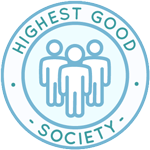 One Community is designing global game-changing cooperatives through a Highest Good society approach to living that is founded on fulfilled living, the study of meeting human needs, Community, and making a difference in the world:
One Community is designing global game-changing cooperatives through a Highest Good society approach to living that is founded on fulfilled living, the study of meeting human needs, Community, and making a difference in the world:
- Read the Highest Good society overview: Highest Good Society
- Learn about the model for fulfilled living and sharing: A Day in the Life
- Learn about the 4 economic models: RBE | For-profit | Non-profit | Entrepreneurship
- Learn about our open source community collaboration and management software: The Highest Good Network
This week, the core team completed over 55 hours managing One Community’s volunteer-work review not included above, emails, social media accounts, web development, new bug identification and bug-fix integration for the Highest Good Network software, and interviewing and getting set up new volunteer team members. They also shot and incorporated the video above that talks about global game-changing cooperatives and how global game-changing cooperatives are a foundation of the bigger picture of everything One Community is doing. The image below shows some of this work.
Anoushka Hazari (Data Analyst) continued working on code to automate and simplify the Highest Good Network software promotion process. This week, Anoushka reviewed her teams pull requests and updated the PR review table, while also welcoming new members to the team. She wrote a blog, created a collage to accompany it, and corrected a previous error to ensure accuracy. She updated the HGN spreadsheet with necessary changes and reviewed the work listed in Sheet 4, including peer blogs. She continued designing a concept for displaying promoting members on the dashboard, considering factors such as completed hours, PR reviews, and weeks of contribution to determine promotion eligibility. Anoushka explored the potential for global game-changing cooperatives to leverage the HGN platform for enhanced collaboration.
The dashboard framework was refined to track promotion rates, task completion quality, and missed promotions, while also monitoring new member progress and PR review activity across teams. The design incorporates bar charts, heatmaps, and Gantt charts, with a focus on clarity and accessibility using color-coded indicators and interactive elements. Anoushka also worked on defining KPIs and developing visualizations, including pie charts, line charts, and bar charts, to represent the dataset effectively. This work helps One Community’s mission of global game-changing cooperatives and reinforces our commitment to global game-changing cooperatives. The following images show her work for the week.
Chitra Siddharthan (Data Analyst And Team Administrator) continued focusing on the existing web pages of the Highest Good Network Phase II software component. She worked on the weekly summary, Dropbox files, and blog for team Code Crafters for week #621. Tasks were assigned to Honglin and Vinay for HGN Phase 2 action items, and research was done to address Honglin’s questions on Slack. The Material List wireframe, explanations, and expectations were reviewed to clarify questions from Honglin and Vinay regarding their tasks. Work continued on the Phase 2 WBS Google Doc and user manual. Research was done on the expectations for the action item “Tool/Equipment History (List of Issue Log)” to assist Dhrumil in understanding the task requirements, and progress was monitored for action items marked as “WIP.” The User Manual for Phase 2 of the Building Management Dashboard was updated. Additional work was done on the training document, Dropbox, and blog for Govind, Jaiwanth, and Vikas. This work furthers One Community’s mission of global game-changing cooperatives and highlights our commitment to global game-changing cooperatives. The following images show her work for the week.
Feras Rehman (Data Analyst) continued working on developing One Community’s Mastodon account and strategy. He scheduled six more Mastodon posts on Buffer for the following week. Targeted strategies were developed and implemented, resulting in a 5x increase in post reach through optimized hashtag usage and improved post structuring. Additionally, five more Mastodon posts were scheduled on Buffer for the upcoming week. A weekly summary review was completed, and images were added to supplement the summary. This aligns with One Community’s aim for global game-changing cooperatives and demonstrates our ongoing commitment to this objective. The following images show his work for the week.
Hritvik Mahajan (Data Analyst) continued focusing on multiple tasks related to marketing, promotion, software development, social media strategy, and administrative activities. He reposted high-engagement content in Twitter communities to test engagement and updated the strategy management sheet while adjusting to recent changes in Twitter’s community posting rules. In HGN software development, he tested the Phase 1 front-end by reviewing various pull requests, addressing merge conflicts, and following up with team members on Slack. He also refined the design for the HGN Social Media Scheduler in Figma. Additionally, Hritvik listed new bugs in the software document and continued discussions with multiple team members regarding changes. In OC administration, he provided feedback and comments on admin team members’ work for Blog #621 and worked on Blog #620 by covering tasks for another team member, creating collages, and reviewing contributions from the Binary Brigade team. One Community’s pursuit of global game-changing cooperatives is supported by this work, which also strengthens our commitment to global game-changing cooperatives. The following images show his work for the week.
Raghav Dinesh Pamuru (Product Manager) continued focusing on designing and building a Google Sheets dashboard to simplify tracking and analyzing social media engagement, integrating data from multiple sources. He scheduled and attended meetings with several team members to discuss ongoing projects and next steps. He connected with some members regarding the master dashboard creation and planned to engage with the remaining team members next week. He worked on project coordination tasks, including tracking progress, managing documentation, and ensuring alignment across teams. Raghav also contributed to data analysis efforts using SQL and visualization tools to support decision-making, continued refining workflows and processes to improve efficiency and collaborated on multiple initiatives requiring cross-functional input. This work contributes to One Community’s vision of global game-changing cooperatives and underscores our commitment to global game-changing cooperatives. The following images show his work for the week.
Rahul Bavanandan (Data Analyst) continued working on several key projects within the Highest Good Network software, One Community’s Reddit presence, and administration. He worked on the HGN Phase 2 Evolution project, focusing on Figma visualizations. He implemented updates to the Phase 2 dashboard designs based on feedback. He also provided review and feedback to five colleagues on their work. Additionally, he accessed the blog from the Defining Our Avatar page, verified the version, and optimized it using SEO best practices. He completed the Weekly Content Administrator role, compiling all administrators’ blogs into the main blog post and preparing it for publication. This work helps One Community’s mission of global game-changing cooperatives and reinforces our commitment to global game-changing cooperatives. The following images show his work for the week.
Vimarsh Acharya (Engineering Manager and Technical Reviewer) continued working on identifying sustainability-related arguments covering the Highest Good Lifestyle Considerations and sourcing quality research to support each one. Vimarsh worked on AI music selection, sorting through a collection of more than 850 songs to categorize and organize them based on relevant criteria. This involved identifying patterns, structuring the data, and ensuring accessibility for future use. The One Community model, which combines forward-thinking education with sustainably built classrooms like this, is an excellent example of global game-changing cooperatives. See the collage below for his work.
Yash Shah (Data Analyst and Team Administrator) continued his admin work and managed the social architecture component of the Highest Good Network software. He resolved queries for Samman, made adjustments to a task for Pratyush, and responded to comments on the Phase 3 document. Samman and Nishita were assigned development tasks, and an additional five hours were allocated for backend database creation. Three new tasks were added to the document from an organizer’s perspective, with Khushi and Nishita assigned to their development. Rishita requested and was assigned an additional ten hours for backend database creation. Yash created a blog for Dev Dynasty, organized the weekly folder, made a collage, and provided feedback on fellow volunteers’ blogs. One Community champions global game-changing cooperatives; this work reflects that mission and reinforces our commitment to global game-changing cooperatives. The following images show his work for the week.
Zuqi Li (Administrative Assistant and Economic Analyst) continued managing One Community’s LinkedIn page. She explored LinkedIn Analytics documentation, analyzed dashboards to track projects, updated key metrics, and refreshed dashboards. Additionally, she reported LinkedIn messages to Jae for responses, reviewed post-editing documentation, and planned content for the upcoming week. She also met with Preksha to discuss improvements in LinkedIn Analytics tasks and scheduled daily LinkedIn posts to boost engagement. This work aligns with One Community’s goal of global game-changing cooperatives and emphasizes our commitment to global game-changing cooperatives. The following images show her work for the week.
ADMINISTRATION TEAM
The Administration Team’s summary, covering their work administrating and managing most of One Community’s ongoing process for designing global game-changing cooperatives was managed by Sneka Vetriappan (Data Analyst) and includes Dishita Jain (Data Analyst and Team Administrator), Govind Sajithkumar (Software Project Manager), Jaiwanth Reddy Adavalli (Software Project Manager), Jibin Joby (Data Analyst), Keerthi Reddy Gavinolla (Software Developer), Kishan Sivakumar (Administrative Assistant and Software Team Manager), Olawunmi “Ola” Ijisesan (Administrative and Management Support), Pallavi Deshmukh (Software Engineer), Preksha Welankiwar (Digital Marketing Manager), Rachna Malav (Data Analyst), Ratna Meena Shivakumar (Data Analyst and Admin), Saumit Chinchkhandi (Administrative Assistant and Software Engineer), Shrinivas Patil (Software Engineer), Vikas Pande (Software Administrator), and Vishnu Murali (Data Analyst).
This week, Dishita worked on OC administration and orientation tasks, incorporating feedback and adjusting materials. Govind completed onboarding steps, website revisions, and file management. These contributions support the growth of global game-changing cooperatives. Jaiwanth completed his training and orientation tasks, refining his skills. Jibin reviewed work, provided feedback, and contributed to data analysis. Keerthi focused on software testing and reviewed documentation. Kishan reviewed SEO pages and tracked volunteer progress. Ola completed supervisory tasks, monitored promotion eligibility, and updated reports. Pallavi scheduled and handled interviews, tested software functionalities, and reviewed documentation. Preksha interviewed candidates, created social media posts, and contributed to the dashboard. Their combined efforts showcased the potential of global game-changing cooperatives.
Rachna handled interviews, responded to emails, and reviewed SEO pages. Ratna worked on social media content creation, KPI tracking, and dashboard development. These contributions fostered a sense of community, similar to the impact of global game-changing cooperatives. Saumit managed pull request reviews, worked on frontend testing, and assisted with volunteer training. Shrinivas provided feedback on blogs, researched time-use data, and contributed to data interpretation. Sneka reviewed team progress, provided feedback, and managed administrative tasks, including weekly summaries and picture attachments. Vikas completed onboarding processes, revised the WordPress site, and managed file organization. Vishnu evaluated work, collaborated on data analysis, and handled social media account monitoring. One Community’s model for designing global game-changing cooperatives includes developing and maintaining a supportive administration team like this. You can see the work for the team in the image below.
GRAPHIC DESIGN TEAM
The Graphic Design Team’s summary was managed by Harshitha Rayapati (Program Manager) and included Aurora Juang (Graphic Designer), Jaime Yao (Creative Technologist), and Junyuan Liu (Graphic Designer, UI/UX Designer), covering their work on graphic designs for global game-changing cooperatives. This week, Aurora designed icons for One Community’s site map pages using the existing template and created additional social media campaigns. She also worked on social media content creation posts from Google Sheets, including posting new bios for volunteers. Aurora completed her volunteer tasks with a focus on precision and quality. She revised errors, ensured the accuracy of updates, and took the lead in crafting new bio announcements for volunteers. By referencing past tutorials, she verified correct increments and sizing for each profile while providing consistent progress updates to Jae. Additionally, she addressed discrepancies in tutorial videos flagged by Sara, making necessary corrections and updating previous versions to align with current standards. Her contributions this week reflect the spirit of global game-changing cooperatives, fostering collaboration and improvement within the team.
Jaime redesigned social media images for the themes “Better World-Regenerate,” “Cooperation-Change,” and “Cooperation-Food Diversity,” focusing on refining visual messaging and enhancing clarity. Additionally, Jaime completed volunteer announcement pages for Tanmay, Sanket, and Chitra. These projects showcase the power of global game-changing cooperatives in fostering community engagement and driving positive change. Junyuan worked on creating social media content by collecting images and exploring various design options in design software. Three new social media images were completed through an iterative process, and initial steps were taken to search for images and develop design ideas for the next image. Additionally, Junyuan brainstormed approaches for creating future images. See the Highest Good Society pages for more on how this contributes to global game-changing cooperatives. See the collage below to view some of their work.
HIGHEST GOOD NETWORK PROGRESS
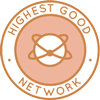 One Community is designing global game-changing cooperatives through open source Highest Good Network® software that is a web-based application for collaboration, time tracking, and objective data collection. The purpose of the Highest Good Network is to provide software for internal operations and external cooperation. It is being designed for global use in support of the different countries and communities replicating the One Community sustainable village models and related components.
One Community is designing global game-changing cooperatives through open source Highest Good Network® software that is a web-based application for collaboration, time tracking, and objective data collection. The purpose of the Highest Good Network is to provide software for internal operations and external cooperation. It is being designed for global use in support of the different countries and communities replicating the One Community sustainable village models and related components.
- Learn about our open source community collaboration and management software: The Highest Good Network
This week, the core team continued their work on the Highest Good Network PRs testing, confirming the fixed PRs for multiple issues, including fixing a bug that prevented users from deleting blue squares (#1197), adjusting the team’s table width to fit all devices (#2802), ensuring form fields clear properly when an image is inserted (#2944), and correcting end date display logic for deactivated accounts (#3016). Additional fixes addressed the implementation of a “View Lessons” button and project dashboard changes (#2911), resolving a bug where clicking outside a modal did not close it (#2763), improving the delete button UI in the team members popup (#3059), and creating a way to change the order of QST codes (#2978). These improvements represent incremental steps towards the realization of global game-changing cooperatives.
Other fixes included resolving a user ID workaround bug affecting dashboard display (#1839, #2801), updating an issue related to viewing tasks with multiple resources for a project (#2609), fixing a reset problem caused by a missing link in WBSItem.jsx (#2807), addressing a profile page issue (#3072), enabling tag deletion from the lesson list (#2916), implementing badge filtering in the badge management page (#2671), and adjusting the assign team button hover effect for smaller resolutions (#2708). One issue related to creating a new team member (#3035) was not fixed. Additionally, they assigned tasks to four volunteers. Details were also provided for the Core Team role regarding the new email function for auto-replying to people who forgot their summary (PR#1104). See the Highest Good Society and Highest Good Network pages for more on how this relates to global game-changing cooperatives. The collage below shows some of their work.
ALPHA SOFTWARE DEVELOPMENT TEAM
The Alpha Team’s summary, covering their work on the Highest Good Network software, was managed by Harshitha Rayapati (Program Manager) and Lin Khant Htel (Frontend Software Developer) and the team includes Eve Ye (Volunteer Software Engineer Intern), Sheetal Mangate (Software Engineer), Sujith Reddy Sudini (Full-Stack Software Developer), Rupa Rajesh Bhatia (Software Engineer), and Vinay Vallabineni (Software Engineer), covering their work on graphic designs for ecological models for thriving.
This week, Lin reviewed and approved PR #3152, tested the codebase locally with all test cases passing, and continued learning about the project. Lin also reviewed and checked the weekly summaries, photos, and videos submitted by Alpha team members and handled Alpha Team management duties, including task assignments and oversight. Eve focused on integrating Pinterest’s OAuth and API functionalities. She explored Pinterest’s documentation, implemented the OAuth process, and tested the API by creating a pin using Postman. For the OAuth process, Pinterest offers two main authorization grant types: Authorization Code and Client Credentials. Initially, Eve selected the Authorization Code grant type, but upon further investigation, she discovered that this would require modifying the database user schema to store tokens for each individual user. Since only the owner of the application will utilize the post pin functionality, Eve ultimately decided to implement the Client Credentials grant type, which is better suited for this use case. Regarding the pin creation functionality, Eve explored the relevant API documentation and used Postman to create a pin. The next step will be to implement this functionality within the application code. Sheetal continued working on the “Development for Re-Engagement Strategies” task from HGN Phase III. She is working on creating branch to start backend work, adding routes, creating API end points and required file structure for the task. Additionally, she reviewed the existing completed PR to ensure alignment with project requirements and referred the existing code to better understand the coding style.
Sujith worked on enhancing the Resource Management component for the Highest Good Network App, addressing ESLint errors and improving code quality. He fixed issues related to missing button type attributes and improper use of array indexes as keys. Additionally, he refined the UI, optimized pagination, and ensured better maintainability of the component. Rupa improved the multi-step form project by updating the design for better responsiveness, using reusable components, and customizing various UI elements. She added interactive features such as sliders, custom input fields, and toggle switches, managed with modular state handlers. Rupa also implemented asynchronous routing for smoother transitions while retaining user inputs, introduced smart logic for dynamic form responses, and added real-time data validation. And she developed custom features for digital signatures and user preferences. As part of managerial training, she collaborated with Sheetal, Vinay, and Sujith to analyze summaries and workflows and reviewed Lin Khant Htel’s project for further learning. This holistic approach to development contributes to the larger goal of global game-changing cooperatives.
Vinay worked on the BM Dashboard materials page. An additional email column was added to the updates and purchases models to improve tracking of users who made updates. The API response was updated to include the email in both models, and the frontend was modified to display the email in a separate column. Pull requests were submitted for both frontend and backend changes. Learn more about how the Highest Good Network will measure and assist in global game-changing cooperatives in the Highest Good Network open-source hub. The collage below shows a compilation of the work from this team.
BINARY BRIGADE SOFTWARE DEVELOPMENT TEAM
The Binary Brigade Team’s summary overseeing advancements in the Highest Good Network software was managed by Vijay Anand Pandian (Full Stack Software Engineer) and Anirudh Sampath Kumar (Software Developer) and includes Aaryaneil Nimbalkar (Software Developer), Geeta Matkar (Software Engineer), Sabitha Nazareth (Software Engineer), Samman Baidya (Software Engineer) and Sriram Seelamneni (Software Engineer). The Highest Good Network software is how we’ll be managing and objectively measuring our progress in designing global game-changing cooperatives through our social architecture, construction, production, and maintenance processes.
This week, Aaryaneil added the GitHub username as a field in the user profile section and modified the backend to support this change. He collaborated with Sabitha to identify issues related to the implementation and discussed potential solutions. API endpoints were tested following the code changes to accommodate the Dropbox media link and GitHub username. A meeting was held with Sabitha to plan the backlog and coordinate the next steps with Jae.
Anirudh worked on multiple pull requests, including PRs 3149, 3136, 3135, 3139, 3162, 3143, 3133, 3161, 3152, and 3159. He also addressed a bug that caused a one-day difference in start and end dates between the reports page and the user management page. The discrepancy was due to differences in time zone formatting, with the user management page displaying dates in Los Angeles time and the reports page using UTC. He identified the relevant code handling date manipulation and made the necessary changes to ensure consistency across both pages. A pull request, PR 3157, was raised to implement these updates.
Geeta worked on date auto-filling for the blue square addition modal. She encountered an issue with the date format and timezone, which was resolved before completing the task. A pull request, PR 3162, was raised for the changes. Additionally, she worked on adjusting the header height to address an ongoing issue.
Sabitha worked on connecting the front end with the back end and identified that the GitHub username was not integrated into the model and was missing from the current project. She and Aaryaneil addressed the GitHub username integration issue and worked on fixing the Dropbox media folder path. To provide more clarity on the issues, Sabitha created a video detailing the problems and sent it to Jae for further instructions.
Samman worked on a Phase III task to track the estimated event value. He created new files named ResourceUsage to handle resource data, estimate values, and present the information in charts and insights. While working on the task, he encountered difficulties locating the necessary data in the backend, as no relevant data appeared to be available for the project. He communicated this issue multiple times and continues to coordinate with the task assigner. The main part of the task was completed, and the project was nearly finished. Final confirmation on the datasets and any required adjustments are still in progress.
Sriram worked on resolving merge conflicts for both backend and frontend pull requests while addressing requested changes from reviews. After resolving the conflicts, he tested the updates to confirm that everything was functioning correctly before finalizing the pull requests. He also reviewed feedback on previously submitted pull requests and made the necessary updates.
Vijay worked on implementing unit tests for the “bmConsumableController” file as part of the HGN software project. He focused on ensuring the accuracy and reliability of this component across multiple work sessions. Additionally, he completed the unit test implementation for the “allUserTimeEntriesActionCreator” file, contributing to the overall stability of the codebase. See the Highest Good Society and Highest Good Network pages for more on how this relates to designing global game-changing cooperatives. View some of the team’s work in the collage below.
BLUE STEEL SOFTWARE DEVELOPMENT TEAM
The Blue Steel Team’s summary, presenting their work on the Highest Good Network software was managed by Nazanin Hashemian (Software Developer, Team Manager) and includes Ramakrishna Aruva (Software Engineer), Sai Girish Pabbathi (Software Engineer), Sharan Sai Marpadaga (Software Developer), and Supriya Sudini (MERN Stack Developer). The Highest Good Network software is how we’ll be managing and objectively measuring our process for designing global game-changing cooperatives through our social architecture, construction, production, and maintenance processes.
This week, Ramakrishna resolved a backend issue by downgrading a library, fixed a member assignment bug, and investigated another issue. Sai fixed the toolbar issue in time logging modals , and work began on the login page for the listing homepage, including setting up components and reviewing authentication requirements. Global game-changing cooperatives fostered innovative solutions for shared challenges. Nazanin resolved a VS Code installation issue on Mac and installed extensions such as Prettier, ESLint, Git Blame, and GitLens. In TaskButton.jsx, she updated task completion logic to track the resolver, and in TeamMemberTask.jsx, she added a “Resolved By” column. She identified a misalignment in task tracking functionality and planned a task details page. This work represents a small but vital contribution toward the development of global game-changing cooperatives.
Sharan worked on a number period issue and continued troubleshooting a Dev-related bug affecting blue squares. Supriya addressed password validation errors in BMLogin, changed the login button text to “Submit,” and refined validation checks to prevent submission of non-compliant passwords. See the Highest Good Society and the Highest Good Network pages to learn more on how their work contributes to designing global game-changing cooperatives. See below to view images of their work.
CODE CRAFTERS SOFTWARE DEVELOPMENT TEAM
The Code Crafters Team, covering their work on the Highest Good Network software, was managed by Swaroop Udgaonkar (Software Engineer) and includes Anjali Maddila (Software Engineer), Ashrita Cherlapally (Software Engineer), Denish Kalariya (Software Engineer), Dhrumil Dhimantkumar Shah (Software Engineer), Humera Naaz (MERN developer), Muhideen Mustapha (Software Engineer), Pavan Swaroop Lebakula (Software Engineer), Pratyush Prasanna Sahu (Software Engineer) and Summit Kaushal (Backend Software Developer). The Highest Good Network software is how we’ll manage and objectively measure our process for global game-changing cooperatives through our social architecture, construction, production, and maintenance processes.
This week, Anjali worked on updating the dashboard to ensure that columns update dynamically based on availability, usage, and wastage. Changes were made to materialsActions.js to improve stock calculations, and MaterialListView.jsx was modified to display real-time stock availability. The dashboard was also updated to allow stock modifications for authorized users. These improvements reflect a growing trend toward global game-changing cooperatives, where shared resources and transparent data drive efficient operations. Additionally, pull requests were raised in the frontend repository (3165) and the backend repository (1228) to merge the implemented changes. Ashrita worked on pull requests and reviewed the details of a new task related to refreshing the profile after setting the final day. She analyzed the issue using the provided video to understand the expected behavior and began identifying possible solutions. The project benefited from her understanding of global game-changing cooperatives, which she applied to streamline the user experience. Additionally, she assessed potential frontend and backend changes required to implement the fix effectively.
Denish fixed a background color issue in the app for UI consistency. He optimized tab data handling to improve the loading speed of the Weekly Summaries Report, which increased the efficiency and responsiveness of report generation. This improvement in report generation represents a key advancement for global game-changing cooperatives, allowing them to access critical data more quickly. His work addressed both UI consistency and performance in critical reporting features. Muhideen worked on a task to notify users through a popup when their permissions changed. The frontend dialog box for the notification was implemented, and development began on the backend component to modify the user profile schema to accommodate a boolean field. Issues were encountered while updating the schema through endpoints in Postman, requiring time to debug and resolve the errors. Global game-changing cooperatives often find that even small schema changes can have widespread impact.
Dhrumil completed work on the Phase 2: Reusables: Single Update task and submitted a pull request. Following this, he reviewed potential tasks to work on and encountered some uncertainties. While Jae was assisting with clarifications, he identified another task within Phase 2 that shared similarities with his previous work. As a result, he took on the 717 Phase 2: Tool/Equipment History (List of Issue Log) task. This demonstrated how individual initiative can contribute to global game-changing cooperatives. Humera worked on PR 1208 to address an edge case where a badge, when incremented and broken, reaches the same badge again. Instead of being replaced, the badge is now decremented and remains in the database while a new badge is awarded. She reviewed the logic to ensure consistency in badge assignments and updated the database structure accordingly. This exemplifies the kind of innovative problem-solving that fuels global game-changing cooperatives.
Additionally, she updated the meeting scheduling system by adding location details for Zoom, phone calls, and on-site meetings. She integrated this information into the database for proper storage and retrieval and modified the scheduling logic to pass location details as a parameter for generating calendar invites. The integration was tested to ensure that invite links included the correct location details and that database updates occurred as expected. Pavan closed task 90, worked on the member filter, reverted previously suggested changes related to the member filter, made backend changes to address an issue with synchronous API loop calls, and worked on integrating the frontend to ensure proper API calls and saving the response as state or an object for table display. These improvements represent a step forward in building global game-changing cooperatives.
Pratyush created a simple landing page displaying a list of events and a basic bar chart representing event times. He worked on a bar chart categorizing event types, labeling them as event type 1, event type 2, etc., and added a highlight section showing the total number of registered members, the most popular event, and the least popular event. He also developed a bar chart illustrating event registration times to identify peak attendance hours. This work showcased the potential of global game-changing cooperatives to organize and visualize community engagement. Additionally, he included a highlight section under the event time bar chart to track repeated participation. UI features were refined, and the alignment of both charts was improved. Summit resolved an issue where new users or users without a badge were not having the badge assigned. They tested for edge cases and potential issues while optimizing code for better readability. Technical issues were encountered when pushing code, which were addressed. This resolution demonstrates the power of global game-changing cooperatives in collaborative problem-solving.
Additional tests were run to check for redundant code, and final tests were completed. Responses to reviewers were sent. Updates were made to the “How to Test” section of the PR to improve clarity. PR1193’s ‘How to Test’ section was edited for readability, including the addition of a walkthrough. Changes were finalized, and additional tests were performed to verify functionality. Swaroop worked on completing the alignment of teams and people reports for smaller screens, ensuring there were no misalignment issues. He made adjustments to the reports and modified JSX files as part of the updates. As a manager-in-training, he reviewed his team members’ work, including photos, videos, and summaries. See the Highest Good Society and Highest Good Network pages for more on how this relates to global game-changing cooperatives. View some of the team’s work in the collage below.
DEV DYNASTY SOFTWARE DEVELOPMENT TEAM
The Dev Dynasty Team’s summary, covering their work on the Highest Good Network software, was managed by Jatin Agrawal (Software Engineer) and includes Honglin Chen (Software Engineer), Ghouse Shahe Meera Ziddi Mohammad (Software Engineer Intern), Nikita Kolla (Full Stack Developer), Nishita Gudiniye (Software Engineer), Shreya Vithala (Software Engineer), Shraddha Shahari (Software Engineer), and Zhifan Jia (Software Engineer). The Highest Good Network software is how we’ll manage and objectively measure our process for global game-changing cooperatives through our social architecture, construction, production, and maintenance processes.
This week, Honglin completed the implementation of PR 3107, fixing mapping logic so that lesson cards display the author and project name instead of the author and project ID. He added a like button feature with seamless frontend and backend updates and raised PR 3158 to resolve console errors on the materials list page, fix data update logic, and implement page navigation for the “add material” feature. These improvements represent a step forward in enhancing user experience, a principle often championed by global game-changing cooperatives. Jatin worked on the “Fix Lead Team Badge Auto-Assignment” issue, creating a PR that is awaiting review. He also developed logic to calculate committed hours for projects and tasks, generating a total sum of project-only and task-only hours.
Nishita worked on the “ENGAGEMENT TAB” of the event management page, implementing toggle functionality between the “comments” and “feedback” sections and developing the “comments” section, including UI for displaying comments with user names and profile pictures, as well as functionality to post comments. Her work contributes to a growing trend of global game-changing cooperatives within the tech industry. Shraddha resolved an issue preventing emails from being sent from the “Send Emails” tab by adding validation to the upload header field after discussions with Hakan. She raised a pull request for the fix and worked on debugging and fixing the incorrect function for assigning a new badge. Shreya focused on identifying necessary code files for the registration confirmation feature, with assistance from Nishita, and worked on adding unit tests for the project info modal to correct previously identified errors. These individual contributions highlight the power of collaborative problem-solving within the context of global game-changing cooperatives.
Zhifan fixed build errors and investigated access issues between the Community Portal and BM Dashboard caused by mismatched login requirements. His contributions supported the growth of global game-changing cooperatives by streamlining platform integration. He implemented pagination for both the frontend and backend, set up synthetic test data, and made improvements to event functionality, including status logic, time zone adjustments, and cover picture display. Nikita worked on resolving merge issues related to creating input method components for forms. She began designing and researching a weekly company summary email for admins and is in the prototype development phase. Her work on improving form inputs and communication tools reflects the innovative spirit of global game-changing cooperatives.
Ziddi focused on fixing a bug related to PR #3163, which depends on PR #2420 containing code changes from Logeshwari. Merge conflicts in PR #2420 prevented it from being merged into the main branch. Testing the fix required logging in as an owner and accessing the permissions management section. A console error was identified and resolved. Global game-changing cooperatives represent a powerful model for collaborative innovation. Ziddi also collaborated with Jae on two hotfixes. The first hotfix addressed an issue preventing admin and owner users from saving changes to user profiles, traced to profiles with warnings. The second hotfix involved modifying time logs across multiple forms, such as tangible and intangible time, time invested, and date tracking. Testing showed that the first fix required adjustments, while the second functioned as expected. See the Highest Good Society and Highest Good Network pages for more on how this relates to global game-changing cooperatives. View some of the team’s work in the collage below.
EXPRESSERS SOFTWARE DEVELOPMENT TEAM
The Expressers Team’s summary, covering their work on the Highest Good Network software, managed by Strallia Chao (Software Engineer) includes Jinda Zhang (Software Engineer/Machine Learning Engineer), Rahul Trivedi (Software Engineer) and Shreya Laheri (Software Developer). The Highest Good Network software is how we’ll manage and objectively measure our process for global game-changing cooperatives through innovative software development, testing, and collaboration.
This week, Jinda enhanced test coverage by implementing unit tests for various source code files. The pull request added unit tests for the authActions.js file, specifically targeting the loginBMUser, logoutUser, refreshToken, setCurrentUser, and setHeaderData actions. These tests ensured that the actions were correctly dispatched, handled both success and error scenarios, and improved the robustness and reliability of authentication actions. The organization championed global game-changing cooperatives, fostering collaborative ventures that reshape established market dynamics.
Rahul reviewed multiple pull requests, focusing on functionality, UI behavior, and test case validation. PRs #3159, #3135, #3095, #3093, #3152, #3139, #3103, #3126, #3122, and #3142 were reviewed, confirming that all test cases passed. PR #3088 was tested for tooltip behavior, ensuring that tooltips appear and disappear correctly. PR #3149 was checked for collapse view functionality and responsiveness, which worked as expected. PR #3128 was tested but encountered a 404 error, which was documented. PR #3046 was verified for search functionality, confirming that spaces were ignored as expected. He also worked on UI testing, reviewing PR #3133 for UI and filter functionality and PR #3085 for image and UI appearance across light and dark modes. The potential for global game-changing cooperatives to reshape economic landscapes remained a topic of discussion.
Shreya focused on refining updates based on feedback. She rewatched Jae’s video to review feedback and independently implemented all necessary changes. After finalizing the updates, she recorded a demo video for Jae to review and provide further input. Shreya’s work reflects the potential of global game-changing cooperatives to foster collaboration and drive impactful results. In addition, she spent time learning Jest to enhance her understanding of unit testing, specifically focusing on core concepts and their application in improving testing workflows. Strallia managed weekly team reviews and reporting, ensuring all team summaries were updated. She worked on resolving backend development issues and incorporated feedback from Tatyana regarding the Total Org Summary page. She also oversaw the backend progress for the summary page, checked in with a team member on their totalSummariesSubmitted component, and provided clarification regarding pull request requirements after a miscommunication. See the Highest Good Society and Highest Good Network pages for more on how this relates to global game-changing cooperatives. See the collage below to view the team’s work.
LUCKY STAR SOFTWARE DEVELOPMENT TEAM
The Lucky Star Team’s summary of the Highest Good Network software, was managed by Anne Zhang (Software Engineer) and includes contributions from Chetan Sunku (Software Engineer), Koushica Bosadi Ulaganathan (Software Engineer), Nikhitha Kalinga (Software Engineer), Neha Bogireddy (Software Engineer), Srikanth Pusthem (Full Stack Developer), Shefali Mittal (Volunteer Software Engineer), and Vaibhavi Madhav Deshpande (Software Engineer). This week, Chetan worked on resolving an issue where the “Export All Badges to PDF” feature did not include newly created and assigned badges, affecting the User Profile section under “Select Featured.”
Koushica reviewed multiple pull requests, focusing on test coverage, UI inconsistencies, feature behavior, and CSS impacts. She provided feedback on PR #3152, verified test cases and mocking implementation, and suggested improvements for PR #3151 related to date picker navigation and button state clarity. She addressed toolbar chevron alignment in PR #3143, access restrictions in PR #3140, and missing route definitions in PR #3128. She also worked on theme synchronization across tabs, ensuring color mode updates reflect immediately across all open tabs, and updated unit tests accordingly. Additionally, she improved time-logging functionality so that logged hours immediately update across relevant sections. Koushica’s work fostered a spirit of global game-changing cooperatives within the team.
Neha reviewed feedback on her PR for the timer pop-out function and continued working on formatting issues in the BM dashboard, with a PR expected soon. She also identified a new task related to progress bar formatting on the main dashboard. Global game-changing cooperatives often foster innovation through collaborative efforts. Nikhitha implemented a user permission button within the Permission Management functionality, allowing authorized users to set or clear the final working day, triggering updates through Redux or an API, and ensuring the UI reflects changes correctly while addressing special cases that prevent updates. This improvement fostered a sense of ownership, much like that seen in global game-changing cooperatives, where collective action drives progress.
Samarth led a 10-member PR review team, tracking their progress, evaluating their assessments, and verifying submitted images. He provided feedback on each document, compiled contributions into a blog post with a collage of submitted images, updated the PR review tracking sheet, and ensured all team members received recognition in the weekly blog. He also coordinated the collection of bios from eligible members and followed up with those who had been asked to submit theirs. He recognized the potential of global game-changing cooperatives to revolutionize traditional business models. Shefali enhanced the Twitter/X auto-poster by adding edit functionality, developing a backend API to allow users to update scheduled posts while ensuring only scheduled posts are displayed for modification before publication. This improvement allows for greater control and flexibility in managing social media content, potentially impacting the way organizations and individuals engage with their audiences, especially within the growing landscape of global game-changing cooperatives.
Srikanth worked on improving concurrency logic in the WBS auto-refresh feature by modifying the addNewTask function to return a status code for success, error, or outdated data. He adjusted the front-end to retain local storage data until a confirmed success response was received, tested isLoading state behavior across user roles, and submitted PR 3170 with these changes, including minimal formatting updates and code comments on concurrency handling. These improvements represent a significant step forward in ensuring data integrity within the system, potentially influencing how other teams approach similar challenges, demonstrating the power of global game-changing cooperatives within our organization.
Vaibhavi worked on the reschedule event task, resolving CSS class conflicts, fixing dependency issues, and rebuilding the feature for proper functionality, continuing backend development to enhance integration and optimization of the rescheduling process. The project benefited from Vaibhavi’s contributions, which fostered a collaborative environment reminiscent of global game-changing cooperatives. Anne focused on an issue with the manager account’s incorrect display of the dropdown menu under Other Links and determined that the bug had been fixed in a recent commit on the main branch. She reviewed the code changes in that commit and identified that the BMHeader.jsx file was not compiling, making debugging more difficult. She also started working on a new issue related to saving blue square reasons and managed the Lucky Star team’s reviews and pictures of the week. See the Highest Good Society and Highest Good Network pages for more on how this relates to global game-changing cooperatives. See the collage below to view the team’s work.
MOONFALL SOFTWARE DEVELOPMENT TEAM
The Moonfall Team’s summary, covering their work on the Highest Good Network software was managed by Newell Newell (Manager), and includes Bhavpreet Singh (Software Engineer), Lalith Kumar Rajendran (Software Engineer), Nikhil Giri (Software Engineer), Shashank Kumar (Software Engineer), Swathi Dharma Sankaran (Software Engineer), Vivek Sharma (Software Engineer), and Yili Sun (Software Engineer). This week, Bhavpreet reviewed eight pull requests over the first two days and then worked on PR 2701 to resolve merge conflicts and verified functionality. Many hours were spent on PR 3169 to address a bug where the phone number toast notification appeared incorrectly. The update ensured that each required field triggers its own toast notification and provided a specific feedback on missing information. The team explored the potential of global game-changing cooperatives to revolutionize their approach to software development.
Lalith analyzed the requested feature and designed an implementation plan. He reviewed the existing codebase before creating a feature branch. Development focused on a “Save Filter” button that appears only when a project code is selected, with functionality to group codes using the “Add Filter” button. Auto-population of the filter bar was implemented when a user selects a saved filter. Lalith’s approach reflected the innovative spirit of global game-changing cooperatives, emphasizing collaborative problem-solving. Nikhil set up a new system following a system crash and completed installations for necessary tools. He resolved an issue with a specific Node.js version before continuing work on the Phase 2 feature for the “Which Tool or Equipment to Update” section in the BM Dashboard. Shashank removed an unintended gray background from the header banner and merged a pull request for the fix. He continued working on the list and bidding pages and focused on layout improvements. The profile page layout was changed from Reactstrap to CSS Grid to resolve spacing issues and improve structural alignment. He believes that global game-changing cooperatives represent a powerful model for equitable economic development.
Swathi modified the SummaryBar.jsx file to remove “NaN” values from suggestion categories in dropdowns and replaced them with a numbered list for improved clarity. The select input was adjusted to properly format options and additional modifications were made in the user suggestion modal to enhance readability and maintain consistency. These enhancements underscore the power of global game-changing cooperatives in fostering collaborative development. Vivek worked on setting a default tab for users without a team and determined that a fresh implementation was necessary due to conflicts with recent changes. He included observations from the review and relocated initial tab-setting logic to useEffect. Yili completed unit tests for PeopleTableDetails.jsx on the Reports page and verified data rendering, interaction behaviors, and edge cases. She reviewed test results and necessary adjustments were made to align with expected functionality. See the Highest Good Society and Highest Good Network pages for more on how this relates to global game-changing cooperatives. Below is a collage for the team’s work.
REACTONAUTS SOFTWARE DEVELOPMENT TEAM
Reactonauts’ Team’s summary, covering their work on the Highest Good Network software was managed by Vijeth Venkatesha (Software Engineer) and includes Gmon Kuzhiyanikkal (Software Engineer), Haoyue Wen (Software Engineer), Keying Guo (Software Engineer), Khushi Jain (Software Engineer), Mohan Gopi Gadde(Software Engineer), Nikhil Pittala (Software Engineer), Pallavi Thorat (PR Team O-Sh), Peterson Rodrigues (Full-Stack MERN Stack Developer), Rishitha Mamidala (Software Engineer), Saniya Farheen (Software Engineer), Sharadha Shivakumar (Software Engineer), and Xiyan Li (Software Engineer Intern).
This week, Gmon took on a new task for global game-changing cooperatives—finishing the fix so that members’ tasks are hidden with the team’s toggle and adding bell notifications at 50%, 75%, and 90% of the task deadline. He noticed that a PR already exists and could now be marked as complete. He also completed his task of adding active/inactive numbers by teams on the team page, and a new pull request branch has been created, named Gmon-Active-NonActive-team. The PR number is PR 2850, and it is currently waiting for review. The old PR 2609 is under final review, awaiting approval from team members, after which it can be pushed to the main branch. All relevant screenshots and videos highlighting PR 2850 have been added and uploaded to Dropbox for reference. Additionally, he spent time understanding the project’s architecture and existing features to prepare for upcoming tasks and contributions within global game-changing cooperatives.
Haoyue focused on resolving complex merge conflicts and addressing code review feedback to refine the Quick Setup Tool for global game-changing cooperatives. She also worked on debugging critical issues, ensuring the tool functions smoothly and aligns with project specifications. Additionally, she made progress on developing the FAQ tool, incorporating the latest specifications to improve interaction within the application. Keying worked on optimizing a filtering function for global game-changing cooperatives, specifically attempting to implement a multi-select feature when selecting a user. Despite multiple attempts, the added functionality did not work as expected, and the filter failed to operate correctly when additional selections were introduced. Additionally, Keying encountered performance issues with a specific page, where loading times remained long even on a high-performance machine. After loading, any code errors prevented the filter from functioning entirely. Keying also explored potential testing strategies under these conditions to diagnose and resolve the filtering issues effectively.
Khushi focused on developing Phase 3 – Event Management Page for the organizer’s view within global game-changing cooperatives. This page, accessible at /communityportal/activity/:activityid, is designed to provide event organizers with a structured interface to oversee and manage their events efficiently. It allows them to update event descriptions, track engagement analytics, and monitor real-time status updates. The page features an Event Information Section displaying key details such as event name, location, organizer information, date, time, and Zoom link. A Status & Rating System indicates whether the event is active or completed, along with its overall rating. A Date Selector Dropdown and Calendar View enhance usability, allowing organizers to switch between event dates and track scheduling. The Description Box offers an editable text area where organizers can modify event details, add media, and submit updates.
Additionally, the interface includes navigation tabs—Description, Analysis, Resource, and Engagement—for event management. The layout incorporates a Top Navigation Bar with quick access to the Dashboard, BM Dashboard, Timeline, Project, Reports, and User Profile. The left panel highlights event-specific details, while an interactive dropdown facilitates date selection. A calendar component visually marks event days, ensuring seamless scheduling. Through this development, Khushi is optimizing the event management experience, making it more intuitive and functional for organizers within global game-changing cooperatives. Mohan worked on resolving merge conflicts in an older pull request related to the inactive button and people reports in the project for global game-changing cooperatives. The process involved identifying the source of the conflicts and determining an approach to integrate updates while preserving recent changes and ensuring compatibility with the existing codebase. Steps were taken to merge the necessary modifications without introducing regressions or disrupting functionality.
Nikhil worked on writing unit tests for the action creators in the userManagement.js file within global game-changing cooperatives. He focused on verifying that the action creators produce the expected outputs based on different inputs and conditions. This involved setting up test cases, mocking necessary dependencies, and ensuring proper assertions were in place. Debugging was done to address any issues encountered during testing. The tests were reviewed to confirm they align with project requirements and improve overall code reliability. Pallavi worked on resolving lint-related issues in a PR and reviewed multiple PRs to verify functionality, responsiveness, and test case results for global game-changing cooperatives. The /communityportal/reports/event/personalization page was tested for both Admin and Volunteer roles, confirming expected behavior, including responsiveness. PRs 3131, 3127, 3125, 3095, and 3122 were reviewed, with all test cases passing.
PR 3149, which introduced a new default and collapse view in the BM Dashboard for Phase II, was tested to ensure correct functionality and user interaction. PR 3085 was verified to confirm that activity images, descriptions, and schedules were displayed correctly. PR 3060 was tested to check that the navbar functioned as expected. PR 3159 introduced unit tests for the authActions.js file, covering login, logout, refresh token, and user authentication actions, with all test cases passing. In addition to reviewing PRs, efforts were made to identify and address potential issues affecting system behavior, ensuring that implemented features met project requirements within global game-changing cooperatives. The verification process involved checking UI elements, interactive components, and expected outcomes based on predefined test cases. Test cases for reviewed PRs were validated to confirm that changes did not introduce new issues or regressions. The testing approach included assessing different user roles and varying screen sizes to ensure a consistent experience. Work on resolving lint-related issues helped maintain code quality and adherence to best practices. Collaboration with team members ensured that feedback was addressed, and any concerns raised during reviews were resolved before merging changes.
Peterson fixed a bug on the Dashboard page for global game-changing cooperatives that occurred when the user selected a profile picture in SVG+XML format on the User Profile page. The fix now allows users to submit the summary normally, even with a profile picture in this format. Rishitha Mamidala completed the development of front-end visualizations for No-Show Rate Reports as part of Phase 3 for global game-changing cooperatives, submitting PR 3156 and PR 1227. The work included designing demographic breakdown charts to display no-show rates and creating comparison visuals to identify trends across different event types and locations. Additionally, the back-end logic was developed to calculate no-show rates segmented by demographics, event type, and location.
Saniya examined a bug to determine whether it was functioning correctly, as she had not received enough PR reviews to confirm its status. She considered the possibility of an issue affecting its expected behavior. Once she receives 10 PR approvals, she will begin working on another bug, and Jae will merge the current one within global game-changing cooperatives. Sharadha worked on the “Create ‘use both filters’ popup and function,” making changes to the collaboration.jsx file to implement the required features. The work is still in progress, as further development depends on the merging of other branches. The “Clear All” feature and tooltip are currently functional, but additional refinements are needed. Further adjustments will be made once the dependencies are resolved, ensuring the filtering system functions as intended within global game-changing cooperatives.
Xiyan focused on integrating a URL shortening service into the highest good network application within global game-changing cooperatives. He developed key components—including the URLService, which manages API interactions, and the URLController, which handles incoming requests. The new feature provides URL shortening, maintains a history of shortened URLs, and offers a copy-to-clipboard function. By leveraging modern web technologies and TypeScript for strong type safety, he ensured error handling throughout the codebase. Vijeth focused on team management and technical investigations within global game-changing cooperatives, overseeing the weekly summary process, reviewing progress updates, and ensuring alignment with project requirements. He analyzed the MongoDB database to identify replicated or redundant data that could be contributing to application slowdown, examining database structures and querying stored data for inefficiencies. See the Highest Good Society and Highest Good Network pages for more on how this relates to global game-changing cooperatives. Below is a collage of the team’s work.
SKYE SOFTWARE DEVELOPMENT TEAM
Skye Team’s summary, covering their work on the Highest Good Network was managed by Preksha Welankiwar (Digital Marketing Manager and Team Admin) and Luis Arevalo (Software Engineer) and the team includes Ikechukwu Gbogboade (Frontend Software Developer), Laura Cohen (Software Engineer), Sai Preetham (Full Stack Developer), Snehal Dilip Patare (Software Engineer), and Yao Wang (Software Engineer). The Highest Good Network software helps manage and objectively measure the designing of global game-changing cooperatives, focusing on social architecture, construction, production, and maintenance processes to build sustainable and thriving ecosystems. This solution is portable, scalable, and ideal for off-grid or sustainable living communities.
This week, Ike focused on the design for global game-changing cooperatives by developing the bidding homepage display for property listings with a user-friendly grid and list format, incorporating high-quality images for each property along with essential details such as titles and primary images. He used placeholders for actual property detail content. Laura focused on improving how user permissions are tracked and updated. After reviewing a teammate’s work to better understand the hasPermission utility, she adjusted how permissions are stored and retrieved. She made changes to ensure the most up-to-date permissions are always available, which is important for ensuring the permission change model works correctly for designing the global game-changing cooperatives.
Luis worked on troubleshooting an issue with warning tracking not appearing. After discussing the problem with Newell, an index was added to ensure MongoDB created the document on the backend. He then worked on generating an in-depth summary text to check if users had not submitted their summaries due to being off. While inspecting this, he encountered an issue preventing new members from being added to teams. After identifying the problem, he reached out to Jae for confirmation on whether he could add members. He also continued implementing the in-depth intro summary, allowing text to be added if a user is off for the week in his support to designing the global game-changing cooperatives.
Sai Preetham worked on implementing backend permission checks for warnings based on feedback from Nathan and Luis. Previously, permissions were managed on the frontend, and changes were made to ensure security and consistency with existing backend structures. Role-based checks were added to grant default permissions to Owner and Administrator roles, preventing issues where they appeared to lack permissions despite having access. Updates were made in the currentWarningsController to validate actions such as adding, updating, and deleting warnings. The requestor object was verified to ensure that user roles were correctly passed for permission checks. These changes were implemented separately to avoid disruptions to existing logic while aligning with the overall permission management system. Testing was done to confirm functionality and resolve any issues, in support to designing the global game-changing cooperatives.
Snehal investigated an issue with the backend API, encountering an invalid token error through Postman. She tested the token with the Facebook Graph API, where the token worked as expected and allowed post creation extending her support to designing the global game-changing cooperatives. Yao continued working on the backend code related to Reddit post functionality, focusing on identifying the cause of an authentication error that prevented posts from being submitted. Debugging efforts included reviewing authentication flows, checking token validity, and testing different configurations to determine why the system blocked post requests. See the Highest Good Society and the Highest Good Network pages to learn more about how their work contributes to the designing for global game-changing cooperatives. See below for the work done by the group.
SOFTWARE PR REVIEW TEAM A-H
The PR Review Team’s summary for team members’ names starting with A-H and covering their work on the Highest Good Network software was managed by Saumit Chinchkhandi (Administrative Assistant and Software Engineer). The Highest Good Network software is a foundation of what we’ll be using to measure our results of global game-changing cooperatives. This week’s active members of this team were: Abdelmounaim Lallouache (Software Developer), Akshay Jayaram (Volunteer Software Engineer), Aureliano Maximus (Volunteer Software Engineer), Carl Bebli (Software Engineer), Carlos Gomez (Full-Stack Software Developer), Ghazi Rahman Shaik (Software Engineer), and Harshitaa Anand (Software Engineer). They reviewed all the Highest Good Network PRs (Pull Requests) shared in this week’s update. Learn more about how the Highest Good Network measures and supports global game-changing cooperatives by exploring the Highest Good Network open-source hub. The collage below shows a compilation of the work from this team.
SOFTWARE PR REVIEW TEAM I-N
The PR Review Team’s summaries for team members’ names starting with I-N and covering their work on the Highest Good Network software was managed by Anoushka Hazari (Data Analyst). The Highest Good Network software is a foundation of what we’ll be using to measure our results for global game-changing cooperatives. This week’s active members of this team were: Jaissica Horra (Software Engineer), Jiaqi Nie (Software Engineer), Kurtis Ivey (Full Stack Developer), Michael Lambo (Software Developer), Nahiyan Ahmed (Full Stack Software Developer) and Nathan Hoffman (Software Engineer). They reviewed all the Highest Good Network PRs (Pull Requests) shared in this week’s update. Learn more about how the Highest Good Network will measure and assist in global game-changing cooperatives in the Highest Good Network open source hub. The collage below shows a compilation of the work from this team.
SOFTWARE PR REVIEW TEAM P-Z
The PR Review Team’s summary for team members’ names starting with P-Z and covering their work on the Highest Good Network software was managed by Olawunmi “Ola” Ijisesan (Administrative and Management Support) and Samarth Urs (Administrative Assistant and Data Analyst). The Highest Good Network software forms the foundation for measuring our results in global game-changing cooperatives. This week’s active members of this team were Sanjeevkumar Hanumantlal Sharma (Software Engineer), Shengwei “Peter” Peng (Software Engineer), Srichand Medagani (Full Stack Developer), Sunil Kotte (Full Stack Developer), Yiyun Tan (Software Engineer) and Yu Yan (Software Engineer). They reviewed all the Highest Good Network PRs (Pull Requests) shared in this week’s update. Learn more about how the Highest Good Network measures and supports global game-changing cooperatives practices by exploring the Highest Good Network open-source hub. The collage below shows a compilation of the work from this team.
AND WE PRODUCED THIS WEEKLY UPDATES BLOG – CLICK HERE TO SUBSCRIBE
FOLLOW ONE COMMUNITY’S PROGRESS (click icons for our pages)
INVESTOR PAGES
GET INVOLVED
DONATE | WAYS ANYONE CAN HELP | MEMBERSHIP
CLICK HERE FOR ALL PAST UPDATES
 One Community
One Community